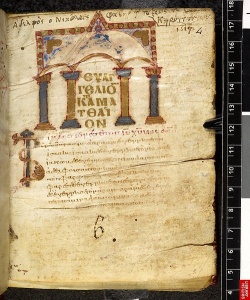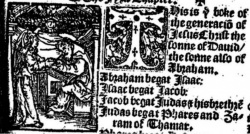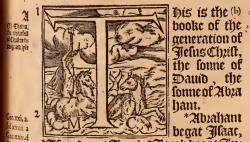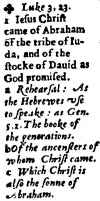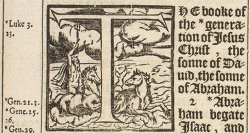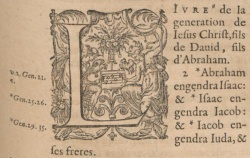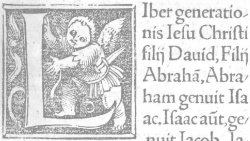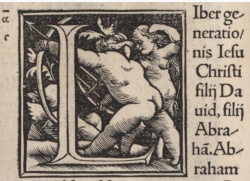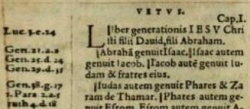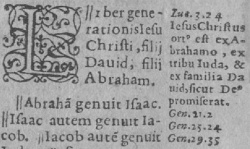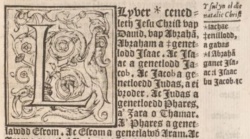Matthew 1:1
From Textus Receptus
(Textus Receptus, Novum Testamentum, Theodore Beza, 5th major edition. Geneva. 1598)
(King James Version, Pure Cambridge Edition 1900)
(King James Version 2016 Edition, & 2023) - buy the revised and updated printed 2023 Edition New Testament here
Interlinear
See Also Matthew 1:1 Interlinear
| Strong's | Greek | Pronunciation | KJV 1611 | KJV 1900 | KJV 2023 | Parts of speech | Case | Tense | Number | Gender | Person | Voice | Mood |
|---|---|---|---|---|---|---|---|---|---|---|---|---|---|
| 976 | ΒΊΒΛΟΣ | vi'-vlos | The booke | The book | The book | Noun | Nominative | - | Singular | Feminine | - | - | - |
| 1078 | γενέσεως | yen'-es-ee-ooce' | of the generation | of the generation | of the generation | Noun | Genitive | - | Singular | Feminine | - | - | - |
| 2424 | Ἰησοῦ | ee-ay-so-oo' | of Iesus | of Jesus | of Jesus | Noun | Genitive | - | Singular | Masculine | - | - | - |
| 5547 | Χριστοῦ | khris-to-oo' | Christ | Christ | Christ | Noun | Genitive | - | Singular | Masculine | - | - | - |
| 5207 | υἱοῦ | hwee-oo' | the sonne | the son | the Son | Noun | Genitive | - | Singular | Masculine | - | - | - |
| 1138 | Δαβὶδ | dav-eeth' | of Dauid | of David | of David | Noun | - | - | - | - | - | - | - |
| 5207 | υἱοῦ | hwee-oo' | the sonne | the son | the Son | Noun | Genitive | - | Singular | Masculine | - | - | - |
| 11 | Ἀβραάμ | av-rah-arm' | of Abraham | of Abraham | of Abraham | Noun | - | - | - | - | - | - | - |
Commentary
Matthew 1:1 is the opening verse of the first chapter of the Gospel of Matthew in the New Testament. Since Matthew is traditionally placed as the first of the four Gospels, this verse commonly serves as the opening to the entire New Testament. It is a sentence without a verb and is more of a heading for what follows in verse 18. The verse is a stand alone verse, much like how in Mark 1:1 it says: “The beginning of the gospel of Jesus Christ, the Son of God;”, and then continues on with the introduction of John the Baptist. Matthew 1:1 meantions Jesus as the Son of David and Abraham, but then changes course and speaks of the genealogy of Joseph, Jesus’s stepfather, and not of Jesus himself.
Matthew 1:1 is a small but significant part of 100s of fulfilled Old Testament prophecies concerning the Jewish Messiah. In Genesis 3:15, 4,000 years before it came to pass, it was spoken that the Seed of the woman would bruise the serpent’s head. In Genesis 22:18, Abraham was told, “in thy seed shall all nations of he earth be blessed.” This descendant or Seed, would be an Israelite of the tribe of Judah, the kingly tribe Matthew 1:1); of the seed of David (2 Samuel 7:12-13); the exact place of His birth, Bethlehem of Judea, was foretold (Micah 5:2), as was the very time of the Messiah’s appearing (Genesis 49:10) and future appearing (Daniel 9:24-26). Then there were the prophecies of His rejection by His own kinsmen (Isaiah 53:2-3); they despised their long-awaited King, the very Hope of Israel. These prophecies were predicted centuries before, and details about His death and its very manner were fulfilled to the letter. There were over 50 prophecies precisely fulfilled on the day of the crucifixion alone! The prophecies of Psalm 22 and Isaiah 53 with the New Testament accounts of the crucifixion are common examples of New Testament literature in the Old Testament.
The book
Βίβλος is translated as ‘The’ book and not simply ‘Book’ due to the normal use of anarthrous nouns in titles, an- + arthrous, from Ancient Greek ἄρθρον (árthron, “joint; grammatical article”). This negates the need for italics here in the article ‘the.’ Anarthrous nouns are generally translated into English with the indefinite article ("a, an"). There are some anarthrous nouns which are qualitative and are often translated without an article. "Anarthrous," in grammar, simply means without the article. In English we have both the definite article (‘the’) and the indefinite article (‘a’), but in Greek there is no indefinite article.
The ending of this noun, -os, tells us that it is nominative in case.
Βίβλος is the inner bark of the papyrus plant which was made into a written book, a sheet, or scroll of writing. There are seven meanings revealed in scripture:
- 1) It is firstly used here as a book, or scroll (Matthew 1:1),
- 2) concerning the Pentateuch as the "book of Moses" in Mark 12:26,
- 3) regarding "the book of the words of Isaiah" that Jesus read from in Luke 3:4,
- 4) the "book of Psalms" in Luke 20:42 and also in Acts 1:20,
- 5) as "the book of the prophets" in Acts 7:42,
- 6) as "the Book of Life" in Philippians 4:3, Revelation 3:5, 20:15
- 7) and of secular writings in Acts 19:19.
- See Also Scriptures Containing 976
The English word Bible stems from the Greek Βίβλος. Interestingly the English word paper comes from papyrus, via Latin, from Greek πάπυρος papyros. The Greek writer Theophrastus, who flourished during the 4th century BC, uses papuros when referring to the plant used as a foodstuff and bublos for the same plant when used for non-food products, such as cordage, basketry, or a writing surface. The more specific term βίβλος biblos, which finds its way into English in such words as bibliography, bibliophile, and bible, refers to the inner bark of the papyrus plant. Papyrus is also the etymon of paper, a similar substance. A folio, borrowed from Latin foliō, is the ablative singular form of folium (“a leaf; a sheet or leaf of paper”), related to foliage.
The Greek word for papyrus as writing material (biblion) and book (biblos) came from the ancient port of Byblos (Lebanese Arabic pronunciation Gebal), which is a Mediterranean city in the Mount Lebanon Governorate, Lebanon. Gubal appears in the Hebrew Bible under the name Geval (Hebrew: גבל). This name means "boundary", "district" or "mountain peak":
- The ancients of Gebal and the wise men thereof were in thee thy calkers: all the ships of the sea with their mariners were in thee to occupy thy merchandise. Ezekiel 27:9 (KJV)
In the New International Version, it is paraphrased as Byblos:
- Veteran craftsmen of Byblos were on board as shipwrights to caulk your seams. All the ships of the sea and their sailors came alongside to trade for your wares. Ezekiel 27:9 (NIV)
The Ancient Greek Βύβλος, whence we get our modern Byblos, was the interpretation of Gebal. Papyrus received its early Greek name βύβλος (bublos) from its importation from Egypt to Greece to the Aegean through this city. The Ancient Greek words βίβλος, diminutive βιβλίον (biblos, biblion), plural βίβλοι, diminutive βιβλία (bibli, biblia), and ultimately the word "Bible" ("the (papyrus) book") hence the Holy Bible, derive from that name.
During the Old Egyptian Kingdom, Byblos was virtually an Egyptian colony. First Dynasty tombs used timbers from Byblos. One of the oldest Egyptian words for an oceangoing boat was “Byblos ship”. Many ancient Egyptian objects have been found at Byblos.
Because Beech wood tablets were a common writing material in Germanic societies before the development of paper, the Old English bōc and Old Norse bók both have the primary sense of “beech” but also a secondary sense of “book,” and it is from bōc that the modern word book derives. In modern German, the word for “book” is Buch, with Buche meaning “beech tree.” In the Swedish language, these words are the same, bok meaning both “beech tree” and “book.”
Similarly, in Slavic languages (for example, Russian, Bulgarian, Macedonian) "буква" (bukva—"letter") is cognate with "beech". In Russian and in Serbian and Macedonian, the word "букварь" (bukvar’) or "буквар" (bukvar) refers specifically to a primary school textbook that helps young children master the techniques of reading and writing. It is thus conjectured that the earliest Indo-European writings may have been carved on beech wood. Similarly, the Latin word codex, meaning a book in the modern sense (bound and with separate leaves), originally meant "block of wood".
See Also Βίβλος, Book, Bible, Papyrus, and Anarthrous nouns.
Annotations of Theodore Beza
In his 1556 Latin annotations Beza says of book:
- Liber, Βίβλος, id est. recensio, Hebraeorum idiotismo, vt Genes 5.2.1, ספר תולדות Subauditur autem Hic aliquid eiusmodirvt sit hic titulus, non totius historiae, sed genealogiae. nam etiam hoc totum Βίβλος γενέσεως nihil aliud quàm genealogiam declarat Cicero codem modo libellum nominium dixit.
In his 1598 annotations Beza says of book:
- Liber, Βίβλος. i. recensio, Hebręorū idiotismo, vt Gen 5:1, ספר תולדות [Sepher tholedoth.] quanuis istud sit plurale, & posteros desigent, hoc verò singulare, vt Christi προγόνοις declaret. Subauditur autem, Hoc est, vel aliquid eiusmodi: vt sit hic titulus non totius historiae, sed sequentis genealogiae. Nā etiam hoc totū, Βίβλος γενέσεως, nihil, aliud quàm generis seriem declarat. Cicero similiter libellū nominum dixit.
Edward Leigh
Edward Leigh (1602-1671) said:
- The Booke] This first word of the first Evangelist, is a Greeke word, but in signification Hebrew. It is taken after the manner of the Hebrewes, who Gen. 5.1. have Sepher tholedoth, the booke of the generation, that is, a catalogue or reckoning up, but Moses speakes of the catalogue of the generation of Adam, Matthew of the booke of the generation of Jesus: so that generation is taken there actively, for them which Adam begot, that is, his posteritie; here passively, for those of which Christ is begotten, that is, for the Ancestors of Christ. ([6])
of the generation
γενέσεως of the generation, means something that has been generated, in this case, it is what Jesus Christ has generated. The genealogy beginning in verse 2 mentioned is of Joseph, and not Jesus. Thus the New King James Version’s translation is in error having "The genealogy of Jesus Christ" because Christ had no genealogy except through His mother (Luke 3). Nowhere else in the New Testament does book refer to anything other than an entire work. So it is erroneous to conclude that it is only concerned with the listed genealogy.
In the KJV Matthew 1:1 has ‘genesis’ translated as generation (also translated as nature) never as birth, nor as genealogy, which is a separate and distinct word used in the Pastorals.
100s of "gn" sounding words appear in the etymology of Indo-European languages such as Latin, Greek, and English. The "gn" sounding is usually associated with production, birth or origin, such as genesis, beginning, origin, genetics, progenitors, gender, genitals, pregnancy, progeny, congenial, indigenous, geneus, genre, generation etc. A Latin example would be in Matthew 1:25 where primogenitum is used for firstborn. In Latin, gens means a clan, from Hebrew; Gentiles are foreigners. In Greek there are many even in this first chapter of Matthew with egenesay (from gennao) being translated as begat/begot. Just as Gnat has a silent g, some "gn" sounding words also dropped the g, such as gnoel (noel) in the gnativity (naitivity) song. Other examples are nation, nature, innate, benign (used to mean well born), the opposite was malign - but the g sound is maintained in benignant and malignant. The root of this verb is γενε-, not γεν. You can see this in other compound forms such as γενετωρ, which corresponds to Latin genitor, Sanskrit janitar-.
The exact phrase 'Βίβλος γενέσεως’ is used in 5:1 in the so called Greek Septuagint. γενέσεως is used in Genesis 2:4 which is correct because it concerns what originated from God’s creation which also may include genealogies of men. Matthew 1:1, is applied to what Christ generated. The LXX has:
- αὕτη ἡ βίβλος γενέσεως οὐρανοῦ καὶ γῆς ὅτε ἐγένετο ᾗ ἡμέρᾳ ἐποίησεν ὁ θεὸς τὸν οὐρανὸν καὶ τὴν γῆν Genesis 2:4
- αὕτη ἡ βίβλος γενέσεως ἀνθρώπων ᾗ ἡμέρᾳ ἐποίησεν ὁ θεὸς τὸν αδαμ κατ’ εἰκόνα θεοῦ ἐποίησεν αὐτόν. Genesis 5:1
See Also Genesis 37:2 and Numbers 3:1.
The βίβλος in the βίβλος γενέσεως of Genesis 2:4 is an addition which does not appear in the original Hebrew. It was most probably copied from Matthew 1:1 into Genesis 2:4, erroneously carrying the βίβλος with it, which is more proof of a reverse engineered LXX from the New Testament.
In Hebrew the phrase "book of the genealogy" sepher toledoth (סֵפֶר תֹּולְדֹת) is frequent in Jewish writing. The other genealogy concerning the linage of the family of Jesus appears in Luke 3:23-38.
The phrase ‘Βίβλος γενέσεως’ is not merely a title for the first part of the gospel of Matthew (1-17), it is a title for the Gospel of Matthew, and perhaps by default for the entire New Testament itself. It must be noted that the generation of Jesus Christ, applies to everything Christ generated, including His life, death, resurrection, and making of the church.
Cursed Jeconiah
Because Jeconiah was cursed, in no way can the linage of Joseph be part of the linage of Jesus, as many modern versions of the bible mistakenly claim by changing the English reading of "generation" into "genealogy" or "linage."
English Versions Compared
- Following "generation"
- Liber generationis (Wessex Gospels 1175)
- The book of the generacioun (Wycliffe Bible 1382)
- This is the boke of the generacion (Tyndale Bible 1534)
- This is the boke of the generacion (Coverdale Bible 1535)
- Thys is the boke of the generation (Matthew’s Bible 1537)
- Thys ys the booke of the generacyon (The Great Bible 1539)
- The booke of the generation (Geneva Bible 1560)
- This is the booke of the generation (Bishops Bible 1568)
- The booke of the generation (King James Bible 1611)
- The book of the generation (King James Bible 1769)
- The book of the generation (Webster’s Bible 1833)
- THE RECORD of the generation (Etheridge Translation 1849)
- The book of the generation (Julia E. Smith Translation 1876)
- The book of the generation (King James Bible 2016)
- Following "history"
- The History of the life of Jesus Christ (Mace New Testament 1729)
- The History of Jesus Christ (Living Oracles by Alexander Campbell 1835)
- The book of the history (New World Translation 1984) footnote - Or, “line of descent; origin.”
- The historical record of Jesus Christ (Holman Christian Standard Version 2009) footnote - Or The book of the genealogy
- The book of the history (New World Translation 2013) footnote - Or, “genealogy”
- This is a record of the life of Jesus the Messiah (International Standard Version 2012) footnote - Or birth
- Following "genealogy"
- THE book of the nativity (Murdock Translation 1851)
- A roll of the birth (Young’s Literal Translation 1862)
- This is the genealogy (New International Version 1973)
- The book of the genealogy (New King James Version 1982) footnote - Lit. generation
- The Book of the genealogy (Green’s Literal Translation 1993)
- A roll of the birth (Revised Young’s Literal NT 2000)
- The book of the genealogy (World English Bible 2000)
- This is a record of the ancestors (New Living Translation 2007)
- The book of the genealogy (English Majority Text Version 2009)
- The book of the genealogy (Modern English Version 2014)
Another issue is that while the KJV correctly has a full stop at the end of the verse, as does the Greek which is indicating the end of the sentence, modern versions have a semi colon indicating that the genealogy following is of Jesus. For example:
- The book of the generation of Jesus Christ, the son of David, the son of Abraham. KJV
- The book of the genealogy of Jesus Christ, the Son of David, the Son of Abraham: NKJV
Another issue is that most modern versions are translating book (biblos) twice. The NKJV for example says The book of the genealogy. Logy means book. It basically says the book of the family tree book.
Hebrews 7:3 says:
- Without father, without mother, without descent, having neither beginning of days, nor end of life; but made like unto the Son of God; abideth a priest continually.
Chrysostom
Chrysostom in Homilies in Matthew. Homily 2:
- Or he therefore entitles it, “The book of the generation,” because this is the sum of the whole dispensation, the root of all its blessings; viz.10 that God become man; for this once effected, all other things followed of course.
Rabanus Maurus
Rabanus Maurus Magnentius (c. 780 – 4 February 856), also known as Hrabanus or Rhabanus, was a Frankish Benedictine monk and theologian who became archbishop of Mainz in Germany:
- He says, “The book of the generation of Jesus Christ,” because he knew it was written, ‘The book of the generation of Adam.’ He begins thus then, that he may oppose book to book, the new Adam to the old Adam, for by the one were all things restored which had been corrupted by the other.
Giannozzo Manetti
Matthew 1:1 in Giannozzo Manetti’s New Testament.
![Matthew 1:1 in Giannozzo Manetti’s Latin New Testament [1].](/w/images/thumb/c/ce/Matthew_1.1_Giannozzo_Manetti.jpg/300px-Matthew_1.1_Giannozzo_Manetti.jpg)
Erasmus
Theodore Beza γενεσεως
Generationis, γενεσεως, i. maioru ex quibus ortus est Christus: vt Tertul. lib. de carne Christi vertit. Vocabulum autem Generationis retinui, partim quod Christianorum aures illi sint assuetae, partim etiam quod optime videatur Christi exprimere. quia aeternus ille Dei Filius non potest dici ex Dauide & Abrahamo genitus, quin statim veniat in illud Ioannis, Et Sermo ille factusest Caro.
Johannes Piscator
Johannes Piscator in Piscator, Analysis (Matt), p. 12 says:
- Liber generationis. βίβλος γενέσεως. Id est, recensio maiorum, quae usitate nominatur genealogia. Phrasis Hebraea, cuius exemplum extat Gen. 5.v.1. quanquam discrimine duplici. nam illic habetur numero plurali, liber generationum: deinde per generationes illic intelliguntur posteri: dicitur enim, liber generationum Adami: et recensentur illic posteri Adami usque ad Noachum. At hic vocabulo generationis intelliguntur maiores: dicitur enim, Liber generationis Iesu Christi, et recensentur maiores Christi, initio facto ab Abrahamo. An vero numerus singularis γενέσεως pro plurali γενέσεων irrepserit (id quod facile fieri potuit) et hic et in versione Graeca loci ex Genesi citati, incertum est. Nomen libri Hebraeum Sépher, proprie videtur significare recensionem: est enim deductum a verbo Saphár, quod significat numerare: sed per metonymiam adiuncti usurpatur ad significandum librum in quo recensio annotatur: ac tum synecdochice ad signficandum quamvis librum. Generatio autem pro iis qui vel generarunt, ut hic: vel generati sunt, ut in Genesi: per metonymiam effecti vel efficientis dicitur. Etenim generatio ut effectum est generantis: ita efficiens est eius qui generatur. Johannes Piscator, Analysis logica Evangelii secundum Matthaeum. Una cum scholiis et observationibus locorum doctrinae
King James Version


Willem Surenhuis
Willem Surenhuis (1666-1729) in his Liber conciliationis in loca ex Vetere et Novo Testamento (1713) speaks at length about the "genealogy of Jesus".
Adam Clarke Commentary
Adam Clarke in his commentary said:
- The book of the generation of Jesus Christ - I suppose these words to have been the original title to this Gospel; and that they signify, according to the Hebrew Phraseology, not only the account of the genealogy of Christ, as detailed below, but the history of his birth, acts, sufferings, death, resurrection, and ascension.
- The phrase, book of the generation, תולדות ספר sepher toledoth, is frequent in the Jewish writings, and is translated by the Septuagint, βιβλος γενεσεως, as here, by the evangelist; and regularly conveys the meaning given to it above; e.g. This is the book of the generations of Adam, Genesis 5:1. That is, the account of the life of Adam and certain of his immediate descendants. Again. These are the generations of Jacob, Genesis 37:2. That is, the account or history of Jacob, his son Joseph, and the other remarkable branches of the family. And again. These are the generations of Aaron and Moses, Numbers 3:1. That is, the history of the life and acts of these persons, and some of their immediate descendants. The same form of expression is also used, Genesis 2:4, when giving the history of the creation of heaven and earth.
- Some have translated βιβλος γενεσεως, The book of the genealogy; and consider it the title of this chapter only; but the former opinion seems better founded.
Solomon Caesar Malan
See main article Solomon Caesar Malan on Matthew Chapter 1 verses 1 and 18
Solomon Caesar Malan exposes the false concepts of Alford in his book A Plea for the Received Greek Text: And for the Authorized Version of the New Testament in Answer to Some of the Dean of Canterbury’s Criticism of Both:
- Passing over a few trifling matters in the first seventeen verses of this chapter, we come to Dr. Alford’s reading of v. 18.
- Τοῦ δὲ Ἰησοῦ ἡ γένησις οὕτως ἦν, on which he says, in his digest, that
- “γέννησις” of the Received Text, which is a probable correction from the verb so often used before, occurs in L. and the rest.”
- He then gives us his authorities for the change : -—
- “B C P S Z A, 1 syr. Ath. Eus. Dial-trin. expressly;”
- and adds in his notes that -
- “γένησις must be understood in a wide sense, as
- nearly identical in meaning with γέννησις; as=‘origo,’ not merely ‘ birth,’ ” Mey. It probably is chosen by the Holy Spirit to mark a slight distinction [!] between the γέννησις of our Lord and that of ordinary men. See Schol. in digest.”
- I. Before examining Dr. Alford’s authorities, let me say one word on the relative meaning of γέννησις and γένησις, which are not seldom confused by careless Greek writers. Doubtless, according to the scholiast quoted by the Dean, both terms are said ἐν ὁσιότητι εἰς Χριστόν, somewhat as “birth,” “origin,” and “pedigree,” may be said of the same person; though assuredly not in the same sense. Yet, inasmuch as these terms are not applicable to Christ in the same way as they are to every one of us, the fact that Origen, who is supposed to be that scholiast, uses almost exclusively one of those terms, is assuredly not an absolute authority in favour of it; for, in many things, he is not a very safe guide. Let us, then, look at these terms, γένησις and γέννησις, and judge of them on their own merits.
- (1.) As γέννησις comes from γεννάω, and γεννᾷ ἀνήρ παῖδα,1 it is said of the actual procreation of children, as being (1) begotten by the father (γέννήτωρ, γέννήτης, ὁ πατήρ2), and (2) borne and brought forth by the mother (ἀμφοτέρων γεννησάντων3); in which sense γέννησις is used by Plato, when he speaks of αἱ τῶν παίδων γεννησεις καὶ τροφαὶ.1 When, however, he speaks of τῆς γεννησεις καὶ τόκου, 2 he limits γέννησις to the father; for τίκειν κυρίως ἐπὶ γυναἵκα, το δὲ γεννᾷν ἐπὶ ἀνρδά;3 wherefore παρθένος τίκει -τέξεται τὸ ἐν αὐτῇ γεννηθέν.4 Likewise Aristotle τὸ ἂῤῥεν μὲν εἶναι τὸ δυνάμενον γεννᾴν εἰς ἕτερον-τὸ δὲ θῆλυ τὸ εἰς αὐτό. 5
- 1 Thom. Mag. s. v. p. 78.
- 2 Ib. p. 308.
- 3 Arist. περὶ ζ. γεν. i. 17,v 4, ed. Oxf.
(unfinished) [7]
Philip Schaff
Schaff in his Popular Commentary on the New Testament unwittingly reveals were the error originates that genesis simply means birth, the Westcott and Hort text error of having γενέσίς and not γεννέσίς at Matthew 1:18:
- The book of the generation (or, birth, the same word in Greek as in Matthew 1:18). Literally, ‘book of birth, birth-book,’ i.e., pedigree, genealogy. The title of the genealogical table, Matthew 1:1-17, not of the whole Gospel, nor of the first two chapters, nor of chap. 1. Possibly the title of an original (Hebrew) document, used by the Evangelist.
Dean Burgon
In Dean Burgon’s book the Revision Revised, he says:
- Not only do the familiar Parables, Miracles, Discourses of our LORD, trip us up at every step, but we cannot open the first page of the Gospel—no, nor indeed read the first line—without being brought to a standstill. Thus,
- 1. S. Matthew begins,—The book of the generation of JESUS CHRIST (ver. 1).—Good. But here the margin volunteers two pieces of information: first,—Or, birth: as in ver. 18. We refer to ver. 18, and read—Now the birth of JESUS CHRIST was on this wise. Good again; but the margin says,—Or, generation: as in ver. 1. Are we then to understand that the same Greek word, diversely rendered in English, occurs in both places? We refer to the new Greek Text: and there it stands,—γένεσις in either verse. But if the word be the same, why (on the Revisers’ theory) is it diversely rendered?
- In the meantime, who knows not that there is all the difference in the world between S. Matthew’s γέΝΕσις, in ver. 1,—and the same S. Matthew’s γέΝΝΗσις, in ver. 18? The latter, the Evangelist’s announcement of the circumstances of the human Nativity of CHRIST: the former, the Evangelist’s unobtrusive way of recalling the Septuagintal rendering of Gen. ii. 4 and v. 1:393 the same Evangelist’s calm method of guiding the devout and thoughtful student to discern in the Gospel the History of the new Creation,—by thus providing that when first the Gospel opens its lips, it shall syllable the name of the first book of the elder Covenant? We are pointing out that it more than startles—it supremely offends—one who is even slenderly acquainted 120with the treasures of wisdom hid in the very diction of the N. T. Scriptures, to discover that a deliberate effort has been made to get rid of the very foremost of those notes of Divine intelligence, by confounding two words which all down the ages have been carefully kept distinct; and that this effort is the result of an exaggerated estimate of a few codices which happen to be written in the uncial character, viz. two of the IVth century (B א); one of the Vth (C); two of the VIth (P Z); one of the IXth (Δ); one of the Xth (S).
- The Versions394—(which are our oldest witnesses)—are perforce only partially helpful here. Note however, that the only one which favours γένεσις is the heretical Harkleian Syriac, executed in the VIIth century. The Peschito and Cureton’s Syriac distinguish between γένεσις in ver. 1 and γέννησις in ver. 18: as do the Slavonic and the Arabian Versions. The Egyptian, Armenian, Æthiopic and Georgian, have only one word for both. Let no one suppose however that therefore their testimony is ambiguous. It is γέννησις (not γένεσις) which they exhibit, both in ver. 1 and in ver. 18.395 The Latin (generatio) is an equivocal rendering certainly: but the earliest Latin writer who quotes the two places, (viz. Tertullian) employs the word genitura in S. Matth. i. 1,—but nativitas in ver. 18,—which no one seems to have noticed.396 Now, Tertullian, (as one who sometimes 121wrote in Greek,) is known to have been conversant with the Greek copies of his day; and his day, be it remembered, is A.D.190. He evidently recognized the parallelism between S. Matt. i. 1 and Gen. ii. 4,—where the old Latin exhibits liber creaturæ or facturæ, as the rendering of βίβλος γενέσεως. And so much for the testimony of the Versions.
- But on reference to Manuscript and to Patristic authority397 we are encountered by an overwhelming amount of testimony for γέννησις in ver. 18: and this, considering the nature of the case, is an extraordinary circumstance. Quite plain is it that the Ancients were wide awake to the difference between spelling the word with one N or with two,—as the little dissertation of the heretic Nestorius398 in itself would be enough to prove. Γέννησις, in the meantime, is the word employed by Justin M.,399—by Clemens Alex.,400—by Athanasius,401—by Gregory of Nazianzus,402—by Cyril Alex.,403—by Nestorius,404—by Chrysostom,405—by Theodorus 122Mopsuest.,406—and by three other ancients.407Even more deserving of attention is it that Irenæus408 (A.D. 170)—(whom Germanus409 copies at the end of 550 years)—calls attention to the difference between the spelling of ver. 1 and ver. 18. So does Didymus:410—so does Basil:411—so does Epiphanius.412—Origen413 (A.D. 210) is even eloquent on the subject.—Tertullian (A.D. 190) we have heard already.—It is a significant circumstance, that the only Patristic authorities discoverable on the other side are Eusebius, Theodoret, and the authors of an heretical Creed414—whom Athanasius holds up to scorn.415 ... Will the Revisionists still pretend to tell us that γέννησις in verse 18 is a plain and clear error?
393 Αὕτη ἡ βίβλος γενέσεως—οὐρανοῦ καὶ γῆς: also—ἀνθρώπων. 394 For my information on this subject, I am entirely indebted to one who is always liberal in communicating the lore of which he is perhaps the sole living depositary in England,—the Rev. Dr. S. C. Malan. See his Seven Chapters of the Revision of 1881, revised,—p. 3. But especially should the reader be referred to Dr. Malan’s learned dissertation on this very subject in his Select Readings in Westcott and Hort’s Gr. Text of S. Matth.,—pp. 1 to 22. 395 So Dr. Malan in his Select Readings (see above note 1),—pp. 15, 17, 19. 396 Liber genituræ Jesu Christi filii David, filii Abraham ... Gradatim ordo deducitur ad Christi nativitatem.—De Carne Christi, c. 22. 397 A friendly critic complains that we do not specify which editions of the Fathers we quote. Our reply is—This [was] a Review, not a Treatise. We are constrained to omit such details. Briefly, we always quote the best Edition. Critical readers can experience no difficulty in verifying our references. A few details shall however be added: Justin (Otto): Irenæus (Stieren): Clemens Al. (Potter): Tertullian (Oehler): Cyprian (Baluze): Eusebius (Gaisford): Athanas. (1698): Greg. Nyss. (1638): Epiphan. (1622): Didymus (1769): Ephraem Syr. (1732): Jerome (Vallarsi): Nilus (1668-73): Chrysostom (Montfaucon): Cyril (Aubert): Isidorus (1638): Theodoret (Schulze): Maximus (1675): John Damascene (Lequien): Photius (1653). Most of the others (as Origen, Greg. Nazianz., Basil, Cyril of Jer., Ambrose, Hilary, Augustine), are quoted from the Benedictine editions. When we say Mai, we always mean his Nova Biblioth. PP. 1852-71. By Montfaucon, we mean the Nov. Coll. PP. 1707. It is necessity that makes us so brief. 398 Concilia, iii. 521 a to d. 399 i.2 340. 400 P. 889 line 37 (γένησιν).—by Athanasius, 401 i. 943 c.—by Gregory of Nazianzus, 402 i. 735.—by Cyril Alex., 403 v.1 363, 676.—by Nestorius, 404 Concil. iii. 325 ( = Cyril v.2 28 a).—by Chrysostom, 405 vii. 48; viii. 314.—by Theodorus 122 Mopsuest., 406 In Matth. ii. 16.—and by three other ancients. 407 Ps.-Athanas. ii. 306 and 700: ps.-Chrysost. xii. 694. Even more deserving of attention is it that Irenæus 408 P. 470. (a.d. 170)—(whom Germanus 409 Gall. ix. 215. copies at the end of 550 years)—calls attention to the difference between the spelling of ver. 1 and ver. 18. So does Didymus: 410 Trin. 188.—so does Basil: 411 i. 250 b.—so does Epiphanius. 412 i. 426 a (γένησις).—Origen 413 Διαφέρει γένεσις καὶ γέννησις; γένεσις μὲν γάρ ἐστι παρὰ Θεοῦ πρώτη πλάσις, γέννησις δὲ ἡ ἐκ καταδίκης τοῦ θανάτου διὰ τὴν παράβασιν ἐξ ἀλλήλων διαδοχή.—Galland. xiv. Append. pp. 73, 74. (a.d. 210) is even eloquent on the subject.—Tertullian (a.d. 190) we have heard already.—It is a significant circumstance, that the only Patristic authorities discoverable on the other side are Eusebius, Theodoret, and the authors of an heretical Creed 414 [dated 22 May a.d. 359] ap. Athan. i. 721 d.—whom Athanasius holds up to scorn. 415 i. 722 c.
Burgon also mentions Matthew 1:1 in his book The Causes of the Corruption of the Traditional Text of the Holy Gospels while speaking of the double nu issue in γεννημα:
- γεννημα, Matt. iii. 7; xii. 34; xxiii. 33; Luke iii. 7 (the well-known γεννήματα ἐχιδνῶν). A similar confusion between γένεσις and γέννησις, Matt. i, and between ἐγενήθην and ἐγεννήθην, and γεγένημαι and γεγέννημαι. See Kuenen and Cobet N. T. ad fid. Cod. Vaticani lxxvii.III. Itacisms.
Revised Version
The 1881 Revised Version reads as the KJV does:
- The book of the generation of Jesus Christ, the son of David, the son of Abraham.
The problem is with three footnotes that firstly causes generation to be redefined as genealogy, secondly causes both generation (main text) and genealogy (footnote) to be defined as birth, and thirdly birth in verse 18 to be defined as generation.
- 1) In verse 1:1 it says at The book of the generation:
- Or The genealogy of Jesus Christ
- 2) Also in verse 1:1 it says at generation:
- Or birth: as in ver. 18
- 3) At verse 18 it says at birth in 'Now the birth of Jesus Christ was on this wise'...:
- Or generation: as in ver. 1
These three footnotes completely redefine generation to mean only birth and destroy the traditional definition of generation, meaning production.
- 1) Morphs gene - birth and logy - book. Thus making genesis mean birth.
- 2) By making generation mean birth it nullifies the true meaning of genesis and generation.
- 3) By making birth mean generation in verse 18, nullifies the true meaning of genesis and generation.
This threefold error in the 1881 is repeated in the 1900 American Standard Version.
Easton’s Bible Dictionary
- Generation [S]
- Genesis 2:4 , "These are the generations," means the "history." 5:1 , "The book of the generations," means a family register, or history of Adam 37:2 , "The generations of Jacob" = the history of Jacob and his descendants 7:1 , "In this generation" = in this age. Psalms 49:19 , "The generation of his fathers" = the dwelling of his fathers, i.e., the grave. Psalms 73:15 , "The generation of thy children" = the contemporary race. Isaiah 53:8 , "Who shall declare his generation?" = His manner of life who shall declare? or rather = His race, posterity, shall be so numerous that no one shall be able to declare it.
- In Matthew 1:17 , the word means a succession or series of persons from the same stock. Matthew 3:7 , "Generation of vipers" = brood of vipers 24:34 , "This generation" = the persons then living contemporary with Christ. 1 Peter 2:9 , "A chosen generation" = a chosen people.
- The Hebrews seem to have reckoned time by the generation. In the time of Abraham a generation was an hundred years, thus: Genesis 15:16 , "In the fourth generation" = in four hundred years (Compare verse 13 and Exodus 12:40 ). In Deuteronomy 1:35 and 2:14 a generation is a period of thirty-eight years.[1]
Jehovah’s Witnesses
The Jehovah’s Witnesses (J.W.’s) on their JW.ORG website have the following:
- book of the history: Matthew’s opening words in Greek, Biʹblos ge·neʹse·os (form of geʹne·sis), could also be rendered “historical record” or “record of the genealogy.” The Greek word geʹne·sis literally means “origin; birth; line of descent.” It is used in the Septuagint to render the Hebrew term toh·le·dhohthʹ, which has a similar meaning and is usually rendered “history” in the book of Genesis.—Ge 2:4; 5:1; 6:9; 10:1; 11:10, 27; 25:12, 19; 36:1, 9; 37:2.

The J.W.'s following earlier logic written in the appendix of their 1969 Kingdom Interlinear Translation:
- Matthew 1:1 - "history"
- (γένεσις, gen'e·sis, Greek; תולדת, to·ledōth', Hebrew)
- The evident meaning of the Greek word (gen'e·sis) here is history. In Matthew 1:1 it occurs in the very same expression as we find in the Greek Septuagint Version of Genesis 2:4 and 5:1, namely, βίβλος γενέσεως (bib'los ge·ne'se·os).
- At Genesis 2:4 the expression could not refer to the generations of the heavens and the earth, because those inanimate creations could not of themselves generate anything. The French Bible version (1939) by Catholic Canon A. Crampon and the Spanish Bible version (1947) by the Jesuit priest J. M. Bover and Prof. F. Canter a Burgos render the original Hebrew expression at Genesis 2:4 as "history," making the text read: "This is the history of the heaven and the earth." That statement there is not an introduction to what follows, but is the conclusion to the preceding account of the creation. At Genesis 5:1 the Crampon Bible version is consistent in rendering the same original expression as "book of the history, making the verse read: "This is the book of the history of Adam." Again it is evident that this statement is a conclusion to the preceding narrative from Genesis 2:5 down to this verse. The Roman Catholic Confraternity’s English Bible version of Genesis (1948) uses "story" at Genesis 2:4, and the footnote, in part, says: "Story: or history." Darby’s version reads: "histories."
- The Greek word gen'e·sis (Hebrew, to·ledōth') occurs also in the plural number, and evidently means "history," at nine other places in the book of Genesis (Septuagint Version), namely, at Genesis 6:9; 10:1; 11:10, 27; 25:12, 19; 36:1, 9; 37:2. The last of these verses has puzzled many Bible translators because they thought it introduced a genealogy to follow. But, instead, it serves as a conclusion to the story that precedes, from Genesis 36:9 to this verse; and again the Crampon Bible version renders the Hebrew original (ge·ne'seis, LXX) as "history," so that the verse reads: "This is the history of Jacob." The Bover Cantera Spanish Bible version here renders the word "history," but, under a misunderstanding and without warrant, it inserts words to make the verse read: "This is the history of the family of Jacob." Evidently because the rest of Genesis tells of Joseph and his brothers.
- However, the foregoing shows the correctness of the basis for our rendering of the Greek expression at Matthew 1:1 as "the book of the history." It is true that a genealogy at once follows, but it is not of a generation from Jesus Christ; it is a partial list of his forefathers, only from Abraham onward, and especially so because Matthew 1:1 calls Jesus "son of David, son of Abraham." But in those ancient times a history revolved around those contained in a genealogy or those introduced by such a genealogy. Thus the genealogy was an important part of the history given and was in some cases put at the beginning of the history. (See 1 Chronicles, chap- ters 1 to 9.) So it is in the case of "the book of the history of Jesus Christ."
Expositor’s Greek Testament
- Matthew 1:18-25. THE BIRTH OF JESUS. This section gives the explanation which ἐξ ἧς ἐγεννήθη (Matthew 1:16) leads us to expect. It may be called the justification of the genealogy (Schanz), showing that while the birth was exceptional in nature it yet took place in such circumstances, that Jesus might justly be regarded as the legitimate son of Joseph, and therefore heir of David’s throne. The position of the name Τοῦ δὲ Ι. Χ. at the head of the sentence, and the recurrence of the word γένεσις, point back to Matthew 1:1; γένεσις, not γέννησις, is the true reading, the purpose being to express the general idea of origin, ortus, not the specific idea of generation (ὁ εὐαγγελιστὴς ἐκαινοτόμησε τὸ κατὰ φύσιν ὄνομα τῆς γεννήσεως, γένεσιν αὐτὴν καλέσας. Euthy. Zig. on Matthew 1:1).
Cruden’s Bible Dictionary
Cruden’s Bible Dictionary defines Generation as:
- This word is used for the history and genealogy of any man. For example : "This is the book of the generations of Adam," Gen. 5:1. This is the history of Adam’s creation,and that of his posterity. "These are the generations of the heavens and of the earth,"Gen. 2:4. This is a recital of the creation of heaven and earth. And in Matt. 1:1, "The book of the generation of Jesus Christ, the Son of David," This is the genealogy of Jesus Christ, and the history of his life, death, and resurrection.
New King James Version
The NKJV changed this verse to "The book of the genealogy of Jesus Christ..."
We are all are aware that we have the genealogy of Joseph in this chapter, God did not use the Greek word genealogia here (which means "genealogy" exactly, as in 1 Timothy 1:4 and Titus 3:9, and where genealogies are condemned), instead, the Greek word in the Textus Receptus is geneseos.
The KJV translated the Greek word geneseos (which comes from genesis) as "generation", which is precisely what Strong’s Exhaustive Concordance has at 1078 -
- genesis ghen-es-is -- nativity, fig. nature, generation, nature (-ral).
The meaning of "genesis" is origin or birth, or the sphere of this earthly life. So "generation" is faithful and accurate, and subject to further exposition. "Genealogy" is a replacement of "genesis", which is an unauthorized substitution, and changes the meaning. What Matthew is saying is that his Gospel is the book of what Jesus Christ wrought, in His birth, the entire sphere of His earthly life etc. The genealogy of Christ’s stepfather is only a portion of that.
Gavin Basil McGrath
Although written about Matthew 1:18, the note below shows some of the implications of the word change there and how it inadvertently effects Matthew 1:1:
- In the context of Matt. 1:18, gennesis (TR) means “birth” (AV), and genesis (NU Text et al) means “birth” (ASV). The TR’s gennesis is to be preferred as the better reading (MBT, e.g., Lectionaries 2378 & 1968; Jerome’s Latin Vulgate, and various ancient church writers e.g., Irenaeus, Origen, and Chrysostom); as there is no justification in moving away from the MBT reading here. The NU Text’s reading (with support from the Alexandrian Text and e.g., Armenian Version), has the danger that genesis (nominative singular feminine, from genesis-eo s, e ) can also mean “creation,” so that an Arian heretic could misuse the NU Text’s altered reading in a way he could not misuse the TR’s reading of genne gennesis-eo s, e sis (nominative singular feminine, from ). I.e., an Arian could claim Christ’s “genesis” or origins or existence (cf. James 3:6) date from his conception in Mary’s womb. But because the context of Matt. 1:18 has led those using the NU Text’s genesis here to translate it as “birth” (ASV), I include the reading here with qualification, as one “not necessarily affecting the English translation,” although an ASV footnote says at “birth,” “Or, ‘generation,’” though then qualifies this as being synonymous with the “generation” of Matt. 1:1. Nevertheless, the danger still exists, that a heretic could say that he “agrees with e.g., the ASV, NASB, and NIV translation, but when one looks at the underlying Greek in the W-H or NU Text, it shows that Christ’s ‘genesis’ or origins were at his conception in Mary.” Thus the neo-Alexandrian versions open the door to a much greater potential of serious Trinitarian heresy (cf. my comments on “the Spirit of God” at Matt. 3:16). [8]
See Also Genealogy of Jesus and Scriptures Containing Generation, Scriptures Containing Generations, and Scriptures Containing Generation and Generations and Generation
of Jesus Christ
Ἰησοῦ The Hebrew Yeshua means "the LORD (Jehovah) is salvation."
Beza's 1598 has ȣ for οῦ in this and many other places. The οῦ has been retained above for ease of reading.
Χριστοῦ. Christ meaning - The Messiah, anointed one. The word anointed means to be placed into a position, like a king or a priest. A similar word is appointed.
John Mills Novum Testamentum
John Mill omits Χριστοῦ in his “Prolegomena” of 1707, p. cxxiv-a (In his 1710 “Prolegomena” Mill appeals to the Ethiopic version):
- Sed et alias quasdam notare iam lubet, in quibus Codex iste optimus, et aut unus e primaevis, aut ad primaevum aliquem expressus, Archetypum textum retinet in locis nonnullis, ubi ab ipso caeteri, quod video, abierunt. In ipso Evangeliorum limine vix est quam, ut probem simplicem lectionem Aethiopis, βίβλος γενέσεως Ιησοῦ· Matthaei siquidem est ostendere non Jesum Christum a Davide genus ducere; Messas enim (quisquis ille) ab ipso oriturum esse, notum omnibus: sed Jesum Nazarenum e stirpe Davidis, ipsiusque Abrahami fuisse, ideoque vocatum fuisse, (Mat. 1. 16.) h. e. Hebraeorum phrasi, vere fuisse Christum, seu Messiam,...John Mill, “Prolegomena,” in Novum Testamentum. Cum lectionibus variantibus MSS. exemplarium, versionum, editionum, SS. Patrum et Scriptorum ecclesiasticorum; et in easdem notis. Accedunt loca Scripturae parallela, aliaque ἐξηγητικά et appendix ad variantes lectiones. Praemittitur dissertatio, in qua de libris N.T. et Canonis constitutione agitur, historia S. Textus N. Foederis ad nostra usque tempora deducitur, et quid in hac editione praestitum sit, explicatur (Oxford: Theatrum Sheldoniacum, 1707), pp. i–clxxvi
the Son
In the movie Zeitgeist, it was claimed that the word ‘son’ in the term "Son of God" is related to the sun, making Jesus a solar deity. The trouble is that “sun” and “son” cannot be equated. In Hebrew “Son” is pronounced as ben and “sun” is shemesh. In Greek “son” is huios and “sun” is pronounced as helios. (Bible Dictionary Vol. 8 pgs. 1033-50) — Given that the two terms are only similar in English but not in the original Biblical languages, the most important piece of evidence that supposedly identifies Jesus as a Sun god and as the center of the Zodiac is superficial.
Modern English Version
The 2014 MEV has son without the capital S in both instances in this verse.
of David
υἱοῦ Δαβίδ. The "Son of David" (בֶּן דָּוִד,is a title of the Messiah, the Savior. Matthew 15:22, 20:20, 21:15; Mark 10:47; and Luke 18:38.
Some manuscripts spell Δαβίδ as Δαυεὶδ (with υε in place of a β) and Δαυὶδ (with υ in place of a β). Δαυεὶδ and Δαυὶδ are also forms in the Greek Septuagint.
The word son is capitalized here because the in Matthew 15:22, 20:30, 21:9, 22:42, etc. the KJV in the Pure Cambridge Edition capitalizes the word. Bible Protector claims that lower case “s” demotes Jesus from deity in these examples, but seems to have no issue with Matthew 1:1.
- Matthew 15:22 ...Have mercy on me, O Lord, thou Son of David...
- Matthew 20:30 ...Have mercy on us, O Lord, thou Son of David...
- Matthew 21:9 ...cried, saying, Hosanna to the Son of David...
- Matthew 22:42 ...They say unto him, The Son of David...
In earlier manuscripts, such as Codex Freerianus (Manuscript Washington, W 032), Δαβίδ is abbreviated to “DAD” with Nomina Sacra (a line across the top of these letters) at Matt. 12:23. A scribe working from such a manuscript when later seeking to spell this name out in greater detail, might spell it as, “Dabid” or “Daueid” or “Dauid.” It seems that in the tradition of the Byzantines they varied between such diverse spellings for phonetic reasons.
the Son of Abraham
υἱοῦ Ἀβραάμ. The "Son of Abraham" reveals that Christ is the promised Seed of the Abrahamic covenant. While the title "Son of David" was a common messianic title, "son of Abraham" was an expression that could refer to any Jew.
Some heretics assume that Jesus cannot be of the Seed of Abraham because He had no earthly father. But Jesus was clearly adopted by Joseph, the husband of Jesus’ mother, Mary. So, while Jesus was not conceived by Joseph, he was the certainly considered son of Joseph. Joseph was a descendant of Abraham (see Matthew 1:2-16). In any case, Jesus was a physical descendant of Abraham because he was conceived of Mary. Mary, whose father was Eli, was a descendant of Abraham (Luke 3:23-38). The assumption that Abraham can only have descendants through males is simply mistaken. As can be seen in the case of Zelophehad:
- Numbers 26:33 And Zelophehad the son of Hepher had no sons, but daughters: and the names of the daughters of Zelophehad were Mahlah, and Noah, Hoglah, Milcah, and Tirzah.
- Numbers 27:1-11 Then came the daughters of Zelophehad, the son of Hepher, the son of Gilead, the son of Machir, the son of Manasseh, of the families of Manasseh the son of Joseph: and these are the names of his daughters; Mahlah, Noah, and Hoglah, and Milcah, and Tirzah. And they stood before Moses, and before Eleazar the priest, and before the princes and all the congregation, by the door of the tabernacle of the congregation, saying, "Our father died in the wilderness, and he was not in the company of them that gathered themselves together against the Lord in the company of Korah; but died in his own sin, and had no sons. Why should the name of our father be done away from among his family, because he hath no son? Give unto us therefore a possession among the brethren of our father."
And Moses brought their cause before the Lord.
- And the Lord spake unto Moses, saying, "The daughters of Zelophehad speak right: thou shalt surely give them a possession of an inheritance among their father’s brethren; and thou shalt cause the inheritance of their father to pass unto them. And thou shalt speak unto the children of Israel, saying,
- If a man die, and have no son, then ye shall cause his inheritance to pass unto his daughter.
- And if he have no daughter, then ye shall give his inheritance unto his brethren.
- And if he have no brethren, then ye shall give his inheritance unto his father’s brethren.
- And if his father have no brethren, then ye shall give his inheritance unto his kinsman that is next to him of his family, and he shall possess it: and it shall be unto the children of Israel a statute of judgment, as the Lord commanded Moses.
So, daughters as well as sons are the descendants of Abraham, and it is sufficient for Jesus that he was a son of Mary. The fact that from Genesis the bible clearly talked about the woman’s seed, not the mans. Consider:
- Genesis 3:15 And I will put enmity between thee and the woman, and between thy seed and her seed; it shall bruise thy head, and thou shalt bruise his heel.
- Galatians 3:16 Now to Abraham and his seed were the promises made. He saith not, and to seeds, as of many; but as of one, and to thy seed, which is Christ.
Early Church Writers
Origen
Origen (185 AD-254 AD) wrote:
- For Matthew, writing for the Hebrews who looked for Him who was to come of the line of Abraham and of David, says: (Mt 1:1) The book of the generation of Jesus Christ, the son of David, the son of Abraham. And Mark, knowing what he writes, narrates the beginning of the Gospel; we may perhaps find what he aims at in John; in the beginning the Word, God the Word. But Luke, though he says at the beginning of Acts, The former treatise did I make about all that Jesus began to do and to teach, yet leaves to him who lay on Jesus’ breast the greatest and completest discourses about Jesus. For none of these plainly declared His Godhead, as John does when he makes Him say, I am the light of the world, I am the way and the truth and the life, I am the resurrection, I am the door, I am the good shepherd; and in the Apocalypse, I am the Alpha and the Omega, the beginning and the end, the first and the last.
- 4.22 Ματθαῖος μὲν γὰρ τοῖς προσδοκῶσι τὸν ἐξ Ἀβραὰμ καὶ Δαβὶδ Ἑβραίοις γράφων· Βίβλος͵ φησί͵ γενέσεως Ἰησοῦ Χριστοῦ͵ υἱοῦ Δαβίδ͵ υἱοῦ Ἀβραάμ͵ καὶ Μάρκος͵ εἰδὼς ὃ γράφει͵ ἀρχήν διηγεῖται τοῦ εὐαγγελίου͵ τάχα εὑρισκόντων ἡμῶν τὸ τέλος αὐτοῦ παρὰ τῷ Ἰωάννῃ τὸν ἐν ἀρχῇ λόγον͵ θεὸν λόγον. Ἀλλὰ καὶ Λου κᾶς ἀλλά γε τηρεῖ τῷ ἐπὶ τὸ στῆθος ἀναπεσόντι τοῦ Ἰησοῦ τοὺς μείζονας καὶ τελειοτέρους περὶ Ἰησοῦ λόγους· οὐδεὶς γὰρ ἐκείνων ἀκράτως ἐφανέρωσεν αὐτοῦ τὴν θεότητα ὡς Ἰωάννης͵ παραστήσας αὐτὸν λέγοντα· Ἐγώ εἰμι τὸ φῶς τοῦ κόσμου· Ἐγώ εἰμι ἡ ὁδὸς καὶ ἡ ἀλήθεια καὶ ἡ ζωή· Ἐγώ εἰμι ἡ ἀνάστασις· Ἐγώ εἰμι ἡ θύρα· Ἐγώ εἰμι ὁ ποιμὴν ὁ καλός· καὶ ἐν τῇ Ἀποκα λύψει Ἐγώ εἰμι τὸ Α καὶ τὸ Ω͵ ἡ ἀρχὴ καὶ τὸ τέλος͵ ὁ πρῶτος καὶ ὁ ἔσχατος.(http://ldysinger.stjohnsem.edu/@texts/0250_origen/john/01_john_01-21.htm) Origen (Commentary of St. John’s Gospel, vol. 1, A.E. Brooke, p 6, 20)
Eusebius of Caesarea
Eusebius of Caesarea (260 340) said:
- Βίβλος γενέσεως Ἰησοῦ Χριστοῦ υἱοῦ Δαβίδ υἱοῦ Ἀβραάμ Eusebius of Caesarea (Demonstratio Evangelica, p337, 14, Eusebius Werke, Ivar A. Heikel)
Greek
Textus Receptus
Complutensian Polyglot
See Also Matthew 1:1 Complutensian Polyglot 1514
Aldine
Cephaleus
- 1524 ΒΙΒΛΟΣ γενέσεως Ἰησοῦ Χριστοῦ, υἱοῦ δαβίδ, υἱοῦ άβραάμ. (Wolf Cephaleus. Printed in Strassburg)
Desiderius Erasmus
- 1. 1516 ΒΙΒΛΟΣ γενέσεως ΙΗΣΟΥ ΧΡΙΣΤΟΥ, υἱοῦ Δαβίδ, υἱοῦ άβραάμ (Erasmus 1st Novum Instrumentum omne)
e-rara.ch; Bayerische Staatsbibliothek; GB
- 4. 1527 Βίβλος γενέσεως Ἰησοῦ Χριστοῦ, υἱοῦ Δαβίδ, υἱοῦ άβραάμ. (Erasmus 4th Novum Testamentum omne)
- 5. 1535 ΒΙΒΛΟΣ γενέσεως ἱησοῦ χριστοῦ, υἱοῦ Δαβὶδ, υἱοῦ ἀβραάμ. (Erasmus 5th Novum Testamentum omne)
Colinæus
Sessa
- 1538 ΒΙΒΛΟΣ γενέσεως Ἰησοῦ Χριστοῦ υἱοῦ δαβίδ υἱοῦ άβραάμ. (Printed by Ioannes Antonius de Sabio, funded by Melchior Sessa. Printed in Venice.)
Stephanus (Robert Estienne)

- 1. 1546 ΒΙΒΛΟΣ γενέσεως ἱῦ χῦ υἱοῦ δαβίδ υἱοῦ άβραάμ. Τῆς καινῆς διαθήκης ἅπαντα. Novum Testamentum. Ex bibliotheca regia (Paris: Robertus Stephanus). Hathi Trust
- Österreichische Nationalbibliothek, 1.L.29: ÖNB | GB
- Regensburg, Staatliche Bibliothek, 999/Script.7: MDZ (See Also Nomina sacra)

- 2. 1549 ΒΙΒΛΟΣ γενέσεως ἱῦ χῦ υἱοῦ δαβίδ υἱοῦ άβραάμ. Τῆς καινῆς διαθήκης ἅπαντα. Novum Testamentum. Ex bibliotheca regia (Paris: Robertus Stephanus).
- 3. 1550 Βίβλος γενέσεως Ἰησοῦ Χριστοῦ, υἱοῦ Δαβίδ, υἱοῦ Ἀβραάμ (Novum Testamentum Græce. 3rd edition. Paris. - Editio Regia)
- 4. 1551 Βίβλος γενέσεως Ἰησοῦ Χριστοῦ, υἱοῦ Δαβίδ, υἱοῦ Ἀβραάμ (Novum Testamentum Græce. 4th edition. Genevah)
Theodore Beza
- 1. 1556/57 In Latin (see below) - counted as Beza's first major edition. 1556 Edition and here. 1557 Edition Bibliothèque de Genève, shelf mark Bb 2341
- 1559 unauthorised Basel edition - (Bibliothèque de Genève, shelf mark Bb 2347 e-rara & ULB Sachsen-Anhalt
- 1563: Beza’s Responsio against Castellio (referred to on the title page of the 1565 and 1582 editions): e-rara (Bibliothèque de Genève, shelf mark Bb 150).
- 2. 1565 ΒIBΛΟΣ γενέσεως Iησοῦ Χριστου, υἱοῦ Δαβίδ, υἱοῦ Ἀβραάμ. (Novum Testamentum,- counted as Beza's second major edition. Geneva)

- 1565 (a special copy with Beza’s own handwritten notes in preparation of the third edition (MHR O4 cd (565) a):[9]
- 1565 Minor edition

- 3. 1582 (Novum Testamentum. 2nd folio edition. Geneva.)
- 4. 1588 ΒI'BΛΟΣ γενέσεως Ἰησοῦ Χριστου, υἱοῦ Δαβίδ, υἱοῦ Ἀβραάμ (1588 e-rara] (Lausanne : Bibliothèque, shelf mark 2015);CSNTM; Archive; Google
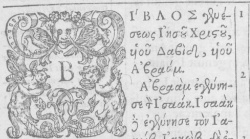
- 5. 1598 ΒI'BΛΟΣ γενέσεως Ἰησοῦ Χριστοῦ, υἱοῦ Δαβίδ, υἱοῦ Ἀβραάμ ([e-rara. Novum Testamentum. 5th. Geneva.])See Also Matthew 1:1 Beza 1598 (Beza)

Plantin Polyglot
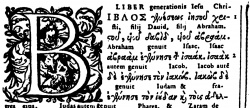
Elias Hutter
- 1599 ΒΊΒΛΟΣ γενέσεως ἰησοῦ χριστοῦ, υἱοῦ δαβὶδ, υἱοῦ ἀβραάμ. (The Nuremberg Polyglot, by Elias Hutter published in Nuremberg).

Elzevir
- 1624 ΒΊΒΛΟΣ γενέσεως Ἰησοῦ Χριστοῦ, υἱοῦ Δαβίδ, υἱοῦ Ἀβραάμ. Isaac Elzevir of House of Elzevir, Novum Testamentum Græce. Lugduni Batavorum [Leiden]: Ex officina Elzeviriana, 1624
- 1633 (Textus Receptus, Novum Testamentum Græce, Isaac Elzevir of House of Elzevir, Lugduni Batavorum [Leiden]: Ex officina Elzeviriana, 1633) (Elzevir) edited by Jeremias Hoelzlin, Professor of Greek at Leiden.
London Polyglot
- 1657 ΒΊΒΛΟΣ γενέσεως Iησοῦ Χριστου, υἱοῦ Δαβὶδ, υἱοῦ Ἀβραάμ. (London Polyglot by Brian Walton. Greek following the work of Robert Estienne's 1550 Textus Receptus)
John Mill
- 1707 ΒIBΛΟΣ γενέσεως IHΣΟΥ Χριστου, υἱοῦ Δαβίδ, υἱοῦ Ἀβραάμ. ((By John Mill. Greek following the work of Robert Estienne's 1550 Textus Receptus))
Footnotes:
- Vers. 1 Luc.3.23, &c. Psal.132.11 Esai.11.1 (collat. cum Act.13.23.) Jer.23.5 Mat.22.42 Gen.12.3 & 22.18 (collat. cum Gal.3.16.)
Scholz
- Footnote Rec. Δαβίδ. [et sic passim].
Scrivener
- 1881 Βίβλος γενέσεως Ἰησοῦ Χριστοῦ, υἱοῦ Δαβίδ, υἱοῦ Ἀβραάμ. (F. H. A. Scrivener , The New Testament in the Original Greek according to the Text followed in the Authorised Version - Cambridge University Press).
Other Greek
- 350 Βίβλος γενεσεως IY ΧY υἱοῦ Δαυεὶδ υἱοῦ Aβρααμ (Codex Vaticanus) 1209 (B or 03) (von Soden δ1) - Vatican Library (See Also Nomina sacra)
- 360 Βιβλος γενεσεως IY ΧY ὑϊου ΔAΔ ὑϊου Ἀβρααμ (Codex Sinaiticus) (א or 01) (von Soden δ2) - British Library Leipzig University Saint Catherine's Monastery (See Also Nomina sacra) (Most probably a forgery)
- 400 - 500 Βίβλος γενέσεως IY ΧY ὑϊου Δ[...]δ ὑϊου Aβρααμʼ (Codex Washingtonianus) (W or 032) (von Soden ε014) (See Also Nomina sacra)[10]
- 700 - 800 Βιβλος γενεσεως ΙΥ ΧΥ ΥΥ ΔΑΔ ΥΥ Αβρααμ· Codex Basilensis (Ee or 07) (von Soden ε55) (See Also Nomina sacra)
- 900 - 1000 Βιβλος γενέσεως ΙΥ ΧΥ· ὑιου ΔΑΔ· ὑιου Ἀβραάμ· (Codex Cyprius (K or 017) (von Soden ε71) (See Also Nomina sacra)
- 1000 - 1100 Βίβλος γενέσεως ιυ χυ υἱοῦ δαδ͵ υἱοῦ ἀβραάμ· (Minuscule 652 (von Soden ε1095) (See Also Nomina sacra)
- 1000 - 1100 Βίβλος γενέσεως ἰυ χυ υἱοῦ δαδ υἱοῦ ἀβραάμ· (Minuscule 43 (8409) (See Also Nomina sacra)
- 1000 - 1100 Βίβλος γενέσεως ιυχυ υυ δαδ υυ ἀβραάμ· (Minuscule 65 (von Soden ε135) Harley MS 5776 (See Also Nomina sacra)
- 1000 - 1100 Βιβλος γενεσεως ιυ χυ υιου δαδ υιου αβρααμ. (Minuscule 72 (von Soden ε110) Harley MS 5647 (See Also Nomina sacra)
- 1100 - 1200 Βιβλος γενεσεως ιυ χυ· υἱου δαδ· υιου αβρααμ· (Minuscule 44 (von Soden ε239) Add MS 4949 (See Also Nomina sacra)
- 1100 - 1200 Βιβλος γενεσεως ιυ χυ· υιου δαδ· υἱȣ* αβρααμ· (Minuscule 57 (von Soden δ255) MS. Gr. 9 (See Also Nomina sacra) * ȣ = οῦ
- 1033 Βίβλος γενέσεως ἰυ χυ· υιου δαδ· υιου αβρααμ· (Minuscule 504 (von Soden ε111) Add MS 17470) (See Also Nomina sacra)
- 1133 Βίβλος γενέσεως ιυ χυ· υιȣ δαδ· υιου ἀβραάμ· (Minuscule 1152, Ms. 129) (See Also Nomina sacra) * ȣ = οῦ
- 1300 - 1400 Bἱβλος γενέσεως ιυ χυ · υἱοῦ δαδ · υἱοῦ ἀβραάμ· (Minuscule 561 (von Soden ε1289) Ms. Hunter 476) (See Also Nomina sacra)
- 1858 (1. 3) Βίβλος γενέσεως Ἰησοῦ Χριστοῦ υἱοῦ Δαυὶδ υἱοῦ Ἀβραάμ. (Constantin von Tischendorf Novum Testamentum Graece. Editio Octava Critica Maior Vol. I, 1869; Vol. II 1872, Leipzig:Giesecke and Devrient. Vol 3, Prolegomena, ed. by Caspar Rene' Gregory, Leipzig: Hinrichs, 1894.)
- 1869 Βίβλος γενέσεως Ἰησοῦ Χριστοῦ υἱοῦ Δαυεὶδ υἱοῦ Ἀβραάμ. (Constantin von Tischendorf Novum Testamentum Graece. Editio Octava Critica Maior Vol. I, 1869; Vol. II 1872, Leipzig:Giesecke and Devrient. Vol 3, Prolegomena, ed. by Caspar Rene' Gregory, Leipzig: Hinrichs, 1894.) based on Codex Sinaiticus.
- 1904 Βίβλος γενέσεως Ἰησοῦ Χριστοῦ, υἱοῦ Δαυῒδ υἱοῦ Ἀβραάμ. (Greek Orthodox (Greek New Testament of the Ecumenical Patriarchate of Constantinople by B. Antoniades))
Anglo Saxon Translations
- 990 her is on cneorisse-bóc hælendes cristes dauides suna. Abrahames suna. (Anglo-Saxon Gospels Manuscript 140, Corpus Christi College by Aelfric) Wessex Gospels
- 1200 Soðliche wel is to understanden þæt æfter matheus ge-rechednysse her is on cneornysse boc. hælendes cristes dauiðes suna. abrahames suna. (Anglo-Saxon Gospels Hatton Manuscript 38, Bodleian Library by unknown author)
English Translations
- 1380 The book of the generacioun of ihesus crist; the sone of dauith, the sone of abraham, (Wyclif's Bible by John Wycliffe)
- 1395 The book of the generacioun of Jhesu Crist, the sone of Dauid, the sone of Abraham. (Wyclif's Bible by John Wycliffe)
- 1534 This is the boke of the generacion of Iesus Christ the sonne of Dauid, the sonne also of Abraham. (Tyndale Bible by William Tyndale)
- 1535 This is the boke of the generacion of Iesus Christ the sonne of Dauid, the sonne of Abraham. (Coverdale Bible)
- 1539 Thys ys the booke of the generacyon of Iesus Chryst, the sonne of Dauid, the sonne of Abraham. (Great Bible First Edition - Miles Coverdale)
- 1540 Thys ys þe booke of the generacyon of Iesus Chryst, þe sonne of Dauid, the sonne of Abraham. (Great Bible Second Edition - Miles Coverdale)
- 1549 Thys is þe boke of þe generation of Iesus Christ þe sonne of dauyd, þe sonne also of Abraham. (Matthew's Bible - John Rogers)
- 1557 The Booke of the generation of Iesus Christe, the sonne of Dauid, the sonne of Abraham. (Geneva 1557) by William Whittingham
- 1560 THe boke of the generaciό of IESVS CHRIST, the sonne of Dauid, the sonne of Abraham.
- 1568 This is the booke of the generation of Iesus Christ, the sonne of Dauid, the sonne of Abraham. (Bishop's Bible First Edition)
- 1572 This is the booke of the generation of Iesus Christ, the sonne of Dauid, the sonne of Abraham. (Bishop's Bible)
- 1582 The booke of the generation of IESVS Christ, the sonne of Dauid, the sonne of Abraham. (Rheims 1582)
- 1587 The booke of the generation of Iesvs Christ the sonne of Dauid, the sonne of Abraham (Geneva Bible) by William Whittingham
- 1599 The booke of the generation of Iesus Christ the sonne of Dauid, the sonne of Abraham. (Geneva Bible) by William Whittingham
- 1611 The booke of the generation of Iesus Christ, the sonne of Dauid, the sonne of Abraham. (King James Version)
- 1729 The History of the life of Jesus Christ, the son of David, the son of Abraham. (Mace New Testament)
- 1745 THE book of the generation of Jesus Christ, the son of David, the son of Abraham. (Mr. Whiston's Primitive New Testament)
- 1762 (King James Version)
- 1769 The book of the generation of Jesus Christ, the son of David, the son of Abraham. (King James Version - Benjamin Blayney)
- 1770 (Worsley Version by John Worsley)
- 1790 (Wesley Version by John Wesley)
- 1795 (A Translation of the New Testament from the Original Greek by Thomas Haweis)
- 1833 The book of the generation of Jesus Christ, the son of David, the son of Abraham. (Webster Version - by Noah Webster)
- 1835 The History of Jesus Christ, Son of David, Son of Abraham. (Living Oracles by Alexander Campbell)
- 1849 THE RECORD of the generation of Jeshu the Meshicha, the son of David, son of Abraham. (Etheridge Translation by John Etheridge)
- 1850 (King James Version by Committee)
- 1851 THE book of the nativity of Jesus the Messiah, the son of David, son of Abraham. (Murdock Translation)
- 1855 Calvin Bible by the Calvin Translation Society
- 1858 (The New Testament Translated from the Original Greek by Leicester Sawyer)
- 1865 A record of descent of Jesus Anointed, son of David, son of Abraham. (The Emphatic Diaglott by Benjamin Wilson)
- 1865 BOOK of the generation of Jesus Christ, son of David, son of Abraham. (The New Testament of Our Lord and Savior Jesus Christ 1865 by American Bible Union)
- 1869 (Noyes Translation by George Noyes)
- 1873 THE book of the generation of Jesus Christ, the son of David, the son of Abraham. (King James Version) by Frederick Scrivener)
- 1885 (Revised Version also called English Revised Version - Charles Ellicott editor)
- 1890 Book of the generation of Jesus Christ, Son of David, Son of Abraham. (Darby Version 1890 by John Darby)
- 1898 A roll of the birth of Jesus Christ, son of David, son of Abraham. (Young's Literal Translation by Robert Young)
- 1901 The book of the generation of Jesus Christ, the son of David, the son of Abraham. (American Standard Version - Philip Schaff)
- 1902 The Lineage Roll of Jesus Christ,––Son of David, Son of Abraham. (The Emphasised Bible Rotherham Version)
- 1902 (Translation of the New Testament from the Original Greek by William Godbey)
- 1904 (The New Testament: Revised and Translated by Adolphus Worrell)
- 1904 (Twentieth Century New Testament by Ernest Malan and Mary Higgs)
- 1911 (Syrus Scofield)
- 1912 The Genealogy of Jesus Christ, the son of David, the son of Abraham. (Weymouth New Testament)
- 1918 (The New Testament Translated from the Sinaitic Manuscript by Henry Anderson)
- 1923 The ancestry of Jesus Christ, who was descended from David, who was descended from Abraham. (Edgar Goodspeed)
- 1982 (New King James Version) Copyright © 1982 by Thomas Nelson.
- 1984 (New International Version)(NIV) Holy Bible, New International Version®, NIV® Copyright © 1973, 1978, 1984, 2011 by Biblica, Inc.®
- 1995 (New American Standard Bible) NASB (©1995)
- 1999 (American King James Version)AKJV
- 2000 (King James 2000 Bible©)
- 2005 (Today’s New International Version)
- (BBE)
- 2009 (Holman Christian Standard Bible)(HCSB) Copyright © 1999, 2000, 2002, 2003, 2009 by Holman Bible Publishers, Nashville Tennessee. All rights reserved.
- (21st Century King James Version) Copyright © 1994 by Deuel Enterprises, Inc.
- (Common English Bible) Copyright © 2011 by Common English Bible
- (GOD’S WORD Translation)(GW) Copyright © 1995 by God's Word to the Nations.
- (Contemporary English Version)(CEV) Copyright © 1995 by American Bible Society
- (New Living Translation)(NLT) Holy Bible. New Living Translation copyright© 1996, 2004, 2007, 2013 by Tyndale House Foundation.
- (Amplified Bible) Copyright © 1954, 1958, 1962, 1964, 1965, 1987 by The Lockman Foundation
- (The Message) (MSG) Copyright © 1993, 1994, 1995, 1996, 2000, 2001, 2002 by Eugene H. Peterson
- (New International Reader's Version) (NIRV) Copyright © 1995, 1996, 1998, 2014 by Biblica, Inc.®.
- (Wycliffe New Testament)
- The book of the generation of Jesus Christ, the Son of David, the Son of Abraham. KJV 2016 (King James Version 2016 Edition)
Foreign Language Translations
See also Bible translations into Afrikaans
Afrikaans
- 1933 DIE geslagsregister van Jesus Christus, (Ta Biblia Ta Logia - J. D. du Toit, E. E. van Rooyen, J. D. Kestell, H. C. M. Fourie, and BB Keet
- 1953 Die geslagsregister van Jesus Christus, die seun van Dawid, die seun van Abraham:
- 1982 Paraphrase - Die Lewende Bybel, Christelike Uitgewersmaatskappy (CUM)
- 1982 South African Bible Society - E. P. Groenewald, A. H. van Zyl, P. A. Verhoef, J. L. Helberg, and W. Kempen
- 1983 © Bybelgenootskap van Suid Afrika
- 2001 The Nuwe Wêreld-vertaling van die Heilige Skrif is an Afrikaans translation of the 1984 English translation of the Bible by the Watchtower Society.
- 2002 Die Boodskap
- 2002 DieBybel@Kinders.co.za - Gert Prinsloo, Phil Botha, Willem Boshoff, Hennie Stander, Dirk Human, Stephan Joubert, and Jan van der Watt.
- 2006 The Nuwe Lewende Vertaling (literally "New Living Translation")
- 2008 Bybel vir Almal - South African Bible Society, Bart Oberholzer, Bernard Combrink, Hermie van Zyl, Francois Tolmie, Christo van der Merwe, Rocco Hough en Elmine Roux.
- 2014 Direct Translation, South African Bible Society
- 2014 Afrikaans Standard Version, CUM Books
Akan
Albabian
- Abrahamit i lindi Isaku; Isakut i lindi Jakobi; Jakobit i lindi Juda dhe vëllezërit e tij.
Amharic
- የዳዊት ልጅ የአብርሃም ልጅ የኢየሱስ ክርስቶስ ትውልድ መጽሐፍ።
Amuzgo de Guerrero
Armenian
- Աբրահամ ծնաւ Իսահակը. Իսահակ ծնաւ Յակոբը. Յակոբ ծնաւ Յուդան ու անոր եղբայրները.
Arabic
See Also Bible translations into Arabic
- 1657 (London Polyglot)
- 1671 Biblia Arabica. de propaganda fide. Arabic and Latin Bible printed in Rome by Abraham Ecchellensis and Louis Maracci
- كتاب ميلاد يسوع المسيح ابن داود ابن ابراهيم (Arabic Smith & Van Dyke)
- 1988 Arabic Life Application Bible (ALAB) Copyright © 1988 by Biblica
- 2009 Arabic Bible: Easy-to-Read Version (ERV-AR) Copyright © 2009 by World Bible Translation Center
Aramaic/Syriac
- ܟܬܒܐ ܕܝܠܝܕܘܬܗ ܕܝܫܘܥ ܡܫܝܚܐ ܒܪܗ (Aramaic Peshitta)
- 1000 ܟܬܒܐ ܕܝܠܝܕܘܬܗ ܕܝܫܘܥ ܡܫܝܚܐ ܒܪܗ ܕܕܘܝܕ ܒܪܗ ܕܐܒܪܗܡ ܀ Khaboris Codex
- 1886 ܟܬܒܐ ܕܬܘ̈ܠܕܬܐ ܕܝܫܘܥ ܡܫܝܚܐ ܒܪܗ ܕܕܘܝܕ ܒܪܗ ܕܐܒܪܗܡ
Basque
- 1571 IESVS CHRIST Dauid-en semearen, Abrahamen semearen generationeco Liburuä.
Bulgarian
- 1940 Родословието на Исуса Христа, син на Давида, син на Авраама. (Матей 1:1) (1940 Bulgarian Bible)
- Родословието на Исуса Христа, син на Давида, син на Авраама. (Матей 1:1) (Bulgarian Bible)
Cherokee
- 1860 ᎯᎠ ᎪᏪᎵ ᎧᏃᎮᎭ ᏧᏁᏢᏔᏅᏒ ᏥᏌ ᎦᎶᏁᏛ, ᏕᏫ ᎤᏪᏥ, ᎡᏆᎭᎻ ᎤᏪᏥ. Cherokee New Testament (CHR)
Chinese
- 1 亚 伯 拉 罕 的 後 裔 , 大 卫 的 子 孙 ( 後 裔 子 孙 原 文 都 作 儿 子 下 同 ) , 耶 稣 基 督 的 家 谱 : (馬 太 福 音 1:1) (Chinese Union Version (Simplified))
- 1 亞 伯 拉 罕 的 後 裔 , 大 衛 的 子 孫 ( 後 裔 子 孫 原 文 都 作 兒 子 下 同 ) , 耶 穌 基 督 的 家 譜 : (馬 太 福 音 1:1) (Chinese Union Version (Traditional))
- 創1:1 起初, 上帝創造天地。 (Chinese King James Version)
Croatian
Czech
Danish
Dutch
Esperanto
Ethiopic
Finnish
French
- 1644 Livre de la generation de Iesus Christ, fils de David, fils d'Abraham. (Giovanni Diodati)
- Livre de la généalogie de Jésus Christ, fils de David, fils d'Abraham: (French Darby)
- 1744 Le Livre de la Généalogie de Jésus-Christ, fils de David, fils d'Abraham. (Martin 1744)
- 1744 Livre généalogique de JÉSUS-CHRIST, fils de David, fils d'Abraham. (Ostervald 1744)
- 1864 (Augustin Crampon)
- 1910
- 2006 Le livre de la génération de Jésus Christ, le fils de David, le fils d’Abraham. (King James Française)
German
- 1350 (Augsburger Bible)
- 1466 (Mentelin Bible)
- 1475 (Gunther Zainer)
- 1476 (Gunther Zainer)
- 1476
- 1477 (Gunther Zainer)
- 1478 (Kolner Bible)
- 1483 (Anton Koberger)
- 1485 (Johann Reinhard de Gruningen)
- 1490 (Johann Schonsperger)
- 1545 Dies ist das Buch von der Geburt Jesu Christi, der da ist ein Sohn Davids, des Sohnes Abrahams. (Luther 1545)
- 1871 Buch des Geschlechts Jesu Christi, des Sohnes Davids, des Sohnes Abrahams. (Elberfelder 1871)
- 1912 Dies ist das Buch von der Geburt Jesu Christi, der da ist ein Sohn Davids, des Sohnes Abrahams. (Luther 1912)
Greek
- 1904 Βίβλος γενέσεως Ἰησοῦ Χριστοῦ, υἱοῦ Δαυῒδ, υἱοῦ Ἀβραάμ. (Greek Orthodox (B. Antoniades))
- ΒΙΒΛΟΣ τῆς γενεαλογίας τοῦ Ἰησοῦ Χριστοῦ, υἱοῦ τοῦ Δαβίδ, υἱοῦ τοῦ Ἀβραάμ. Modern Greek (Trinitarian Bible Society)
Hungarian
Indonesian
- 1733 Surat 'atsal Xisaj 'Elmesehh, 'anakh laki 2 Da`ud, 'anakh laki 2 'Ibrahim. (Leydekker Draft)
- 1863 Sabermoela, ini soerat asalnja JESOES KRISTOES, anak {Luk 1:31,32} Dawoed, anak Ibrahim. (Klinkert)
- 1879 BAHWA inilah sjadjarah ISA ALMASIH, ija-itoe anak Da'oed, anak Iberahim. (Klinkert)
- 1912 Bahwa inilah surat keturunan Isa Almaseh, Anak Daud anak Ibrahim. (Shellabear Draft)
- 1913 Ini-lah kitab kturunan Isa Almaseh, anak Da'ud, anak Ibrahim. (Melayu BABA)
- 1958 Bahwa inilah silsilah Yesus Kristus, yaitu anak Daud, anak Ibrahim. (Terjemahan Lama)
- 1969 Inilah silsilah Jesus, Putera David, Putera Abraham. (ENDE)
- 1974 Inilah silsilah Yesus Kristus, anak Daud, anak Abraham. (Terjemahan Baru)
- 1985 Inilah daftar nenek moyang Yesus Kristus, keturunan Daud, keturunan Abraham. Dari Abraham sampai Daud, nama-nama nenek moyang Yesus sebagai berikut: (BIS)
- 1989 INILAH nenek moyang Yesus Kristus, keturunan Raja Daud dan keturunan Abraham: (FAYH)
- 2000 Inilah silsilah Isa Al Masih, anak Daud, anak Ibrahim: (Shellabear)
- 2006 Inilah silsilah Yesus Kristus. Ia berasal dari keturunan Daud, keturunan Abraham. (WBTC Draft)
- 2008 Kitab silsilah YESUS Kristus, anak Daud, anak Abraham. (MILT)
Italian
[12]- 1607 Libro della generatione di Iesu Christo, figliuolo di Dauide, figliuolo d' Abraham. (Giovanni Diodati Bible 1649)
- 1649 LIBRO della generazione di Gesù Cristo, figliuolo di Davide, figliuolo di Abrahamo. (Giovanni Diodati Bible 1649)
- 1927 Genealogia di Gesù Cristo figliuolo di Davide, figliuolo d’Abramo. (Riveduta Bible 1927)
Japanese
- 1928 アラハムの子、ダビデの子、イエスキリストの系図(けいず)の巻(かん) (Naoji Nagai)
Kabyle
Khmer
Latin
- liber generationis Iesu Christi filii David filii Abraham Latin Vulgate
- 1527 Liber generationis Iesu Christ fili Dauid, fili Abraham. (Erasmus 1527)
- 1527 liber generationis Iesu Christi filii David filii Abraham. (Erasmus Vulgate 1527)
- 1556 L´iber ´generationis IESV Christi ´filii Dauid, ´filii Abraham. (Estienne, Robert; Pagnini, Sante; Baduel, Claude; Bèze, Théodore de; Jérôme, saint; Vatable, François)
- 1567 Liber generationis Jesu Christi, filii David, filii Abraham. (Beza)
- 1592 Liber generationis Jesu Christi filii David, filii Abraham. Sixto-Clementine Vulgate
- 1598 Liber generationis Jesu Christi filii David, filii Abraham. (Beza)
- 1657 Liber generationis Jesu Christi filii David, filii Abraham. (London Polyglot)
- 1858 (1. 3) Liber generationis Iesu Christi filii David filii Abraham. (Constantin von Tischendorf Novum Testamentum Graece. Editio Octava Critica Maior Vol. I, 1869; Vol. II 1872, Leipzig:Giesecke and Devrient. Vol 3, Prolegomena, ed. by Caspar Rene' Gregory, Leipzig: Hinrichs, 1894.)
Latvian
Maori
- 1833
- 1837
- 1858
- 1868 (Formal translation based on the Greek 'Received Text': Trinitarian Bible Society)
- 1833
- 1952
Norwegian
- 1930 Jesu Kristi, Davids sønns, Abrahams sønns ættetavle:
Persian
Pidgin
- 1996 Dispela em i buk bilong ol man i wanlain bilong Jisas Kraist. Em i pikinini man bilong Devit, na Devit em i pikinini man bilong Ebraham. (Pidgin King Jems)
Portugese
Potawatomi
- 1833 (Potawatomi Matthew and Acts)
Romainian
- 1551 (Slavic-Romanian Gospel)
- 1561 (Coresi's Gospel)
- 1570 (The Braşov Psalm Book) Psalms Only
- 1582 (Palia from Orăştie)
- 1648 (The New Testament of Alba Iulia)
- 1688 (Biblia de la Bucureşti - Bucharest Bible)
- 1911 (Nitzulescu - British and Foreign Bible Society)
- 1921 (Cornilescu)
- 1924 (Cornilescu - British and Foreign Bible Society)
- 1989 (Gute Botschaft Verlag)
- 2010 CARTIA naşterii lui Isus Cristos, fiul lui David, fiul lui Avraam. (Biblia Traducerea Fidela în limba româna - Textus Receptus Based)
- 2013 (Biblia Traducerea Fidela în limba română - based upon the Textus Receptus / King James Version)
- 2014 CARTIA naşterii lui Isus Cristos, fiul lui David, fiul lui Avraam. (Biblia Traducerea Fidela în limba română - based upon the Textus Receptus / King James Version)
- 2014 (Cornilescu 90th anniversary definitive edition - British and Foreign Bible Society)
Russian
- 1876 1 - Родословие Иисуса Христа, Сына Давидова, Сына Авраамова. Russian Synodal Version
- Phonetically: Rodoslovie Iisusa Hrista, Syna Davidova, Syna Avraamova.
Sanskrit
Shur
Spanish
See Also Bible translations (Spanish)
- 1543 (Francisco de Enzinas New Testament)
- 1556 (Juan Perez de Pineda New Testament and book of Psalms)
- 1569 Libro de la generación de Jesús, el Cristo, hijo de David, hijo de Abraham. (Sagradas Escrituras)
- 1814 Valera Revision
- 1817 Valera Revision
- 1831 Valera Revision
- 1858 LIBRO de la generacion de Jesu-Cristo, hijo de David, hijo de Abraham. Reina Valera
- 1862 Valera Revision
- 1865 Valera Revision (American Bible Society Revisión)
- 1869 Valera Revision
- 1909 (Reina-Valera) Antigua Spanish Bible
- 1960 Libro de la genealogía de Jesucristo, hijo de David, hijo de Abraham. Versión Reina-Valera (Eugene Nida )
- 1987 Translation from English. Publisher: Watch Tower Bible and Tract Society.
- 1994 Nuevo Testamento versión Recobro
- 1997 (La Biblia de las Américas) (©1997)
- 1999 Nueva Versión Internacional (NVI)
- 2002 EL LIBRO de la generación de Jesu Cristo, hijo de David, hijo de Abraham. (1602 Purificada)
- 2009 Santa Biblia: Reina-Valera
- 1 El libro de la generación de Jesu cristo, hijo de David, hijo de Abraham. (Reina Valera Gómez)
Swahili
- Yesu Kristo alikuwa mzawa wa Daudi, mzawa wa Abrahamu. Hii ndiyo orodha ya ukoo wake:
Swedish
- 1917 Detta är Jesu Kristi, Davids sons, Abrahams sons, släkttavla. (Swedish - Svenska 1917)
Syriac
- 1555 Johann Albrecht Widmanstadt
- 1645 G. Sionita (Paris Polyglot, 1645).
- 1657 B. Walton (London Polyglot, 1657).
- 1823 S. Lee (1823)
- 1852 Urmia edition (1852)
- 1913 Joseph de Qelayta/Trinitarian Bible Society (1913).
- 1892 Mosul edition (1887–92)
- 1851 Beirut (1951)
ܟܬܵܒ̣ܵܐ ܕܝܼܠܝܼܕܘܼܬܹܗ ܕܝܼܫܘܿܥ ܡܫܝܼܚܵܐ: ܒܪܘܼܢܹܗ ܕܕܵܘܝܼܕ: ܒܪܘܼܢܹܗ ܕܐܲܒ̣ܪܵܗܵܡ.
Tagalog
- 1905 Ang aklat ng lahi ni Jesucristo, na anak ni David, na anak ni Abraham. (Ang Dating Biblia 1905)
Thai
- หนังสือลำดับพงศ์พันธุ์ของพระเยซูคริสต์ ผู้ทรงเป็นบุตรของดาวิด ผู้ทรงเป็นบุตรของอับราฮัม (Thai KJV)
Turkish
Ukrainian
- 1871 Книга родоводу Ісуса Христа, сина Давидового, сина Авраамового.
- 1930 Книга родоводу Ісуса Христа, Сина Давидового, Сина Авраамового:
Urdu
- 1878 Yisu Masih, ibn Daud, ibn i Abiraham, ka nasabnama. (Hindustani Roman Script)
- 1938 یِسُوؔع مسیح ابن داؤدؔ ابن ابرؔہام کا نسب نامہ (Urdu Revised Version. British and Foreign Bible Society, 1938)
- 1955 Yisúʻ Masíh, ibn i Dáúd, ibn i Ibráhím ká nasabnáma.
- 2016 یِسُوؔع مسیح ابن داؤدؔ ابن ابرؔہام کا نسب نامہ (Urdu Bible)
Vietnamese
- 1934 Gia phổ Đức Chúa Jêsus Christ, con cháu Đa-vít và con cháu A�p-ra-ham. (Ma-thi-ô 1:1 Vietnamese Bible) (VIET)
Welsh
- 1567 Llyber* cenedleth Jesu Christ bap David, bap Abrahā, (William Salesbury, printed in 1567 by Humphrey Toy)
- Lachae
- 1588 (William Morgan) [13]
- 1620 Llyfr cenhedliad Iesu Grist, fab Dafydd, fab Abraham. (William Morgan)
- 1824
- 1988 (New Welsh Bible)
- 2004
- 2011 (beibl.net 2011 by Arfon Jones)
Critical Apparatus
References
- 1. M.G. Easton M.A., D.D., Illustrated Bible Dictionary, Third Edition, published by Thomas Nelson, 1897.
Commentaries
- Abbott's Illustrated New Testament
- Adam Clarke Commentary
- Henry Alford's Greek
- Barnes' Notes on the Whole Bible
- Calvin's Commentary on the Bible
- Cambridge Greek Testament for Schools and Colleges
- Justin Edwards' Family Bible New Testament
- John Gill's Exposition of the Whole Bible
- Geneva Study Bible
- Greek Testament Critical Exegetical Commentary
- Heinrich Meyer's Critical and Exegetical Commentary on the New Testament
- Johann Albrecht Bengel's Gnomon of the New Testament
- Commentary Critical and Explanatory on the Whole Bible
- John Lightfoot's Commentary on the Gospels
- John Trapp Complete Commentary
- The Popular Commentary by Paul E. Kretzmann
- Matthew Poole's English Annotations on the Holy Bible
- People's New Testament
- Robertson's Word Pictures in the New Testament
- Thomas Coke Commentary on the Holy Bible
- The Fourfold Gospel
- Treasury of Scripture Knowledge
- Vincent's Word Studies
- Expository Notes with Pratical Observations on the New Testament
- Wesley's Explanatory Notes
- F.B. Meyer's 'Through the Bible' Commentary Verses 1-17
- John Broadus' Commentary on Matthew Verses 1-17
- James Gray's Concise Bible Commentary Verses 1-17
- Matthew Henry's Complete Commentary on the Bible Verses 1-17
- Matthew Henry's Concise Commentary on the Bible Verses 1-17
- John Dummelow's Commentary on the Bible Verses 1-25
- Darby's Synopsis of the Whole Bible Verses 1-25
- F. B. Hole's Old and New Testament Commentary Verses 1-25
- Arno Gaebelein's Annotated Bible Verses 1-25
- Ironside's Notes on Selected Books Verses 1-25
- L. M. Grant's Commentary on the Bible Verses 1-25
- Sermon Bible Commentary Verse 1
- The Pulpit Commentaries Verses 1-25
See Also
- Matthew 1:1 Timeline
- Matthew 1:18
- Apollonius' Corollary
- Curetonian Gospels
- Treasury of Scripture Knowledge Matthew 1:1
External Links
- Textus Receptus Bibles, Matthew 1:1
- Treasury of Scripture Knowledge Matthew 1:1
- KJV Asia The Generation of Jesus Christ by KJV Asia
- Wikipedia Article on Matthew 1:1
- Bible Hub Matthew 1:1
- King James Bible Online Matthew 1:1
See Also: Old Testament |
|---|

|
![]() 1 ·
1 ·
![]() 2 ·
2 ·
![]() 3 ·
3 ·
![]() 4 ·
4 ·
![]() 5 ·
5 ·
![]() 6 ·
6 ·
![]() 7 ·
7 ·
![]() 8 ·
8 ·
![]() 9 ·
9 ·
![]() 10 ·
10 ·
![]() 11 ·
11 ·
![]() 12 ·
12 ·
![]() 13 ·
13 ·
![]() 14 ·
14 ·
![]() 15 ·
15 ·
![]() 16 ·
16 ·
![]() 17 ·
17 ·
![]() 18 ·
18 ·
![]() 19 ·
19 ·
![]() 20 ·
20 ·
![]() 21 ·
21 ·
![]() 22 ·
22 ·
![]() 23 ·
23 ·
![]() 24 ·
24 ·
![]() 25 ·
25 ·
![]() 26 ·
26 ·
![]() 27 ·
27 ·
![]() 28 ·
28 ·
![]() 29 ·
29 ·
![]() 30 ·
30 ·
![]() 31 ·
31 ·
![]() 32 ·
32 ·
![]() 33 ·
33 ·
![]() 34 ·
34 ·
![]() 35 ·
35 ·
![]() 36 ·
36 ·
![]() 37 ·
37 ·
![]() 38 ·
38 ·
![]() 39 ·
39 ·
![]() 40 ·
40 ·
![]() 41 ·
41 ·
![]() 42 ·
42 ·
![]() 43 ·
43 ·
![]() 44 ·
44 ·
![]() 45 ·
45 ·
![]() 46 ·
46 ·
![]() 47 ·
47 ·
![]() 48 ·
48 ·
![]() 49 ·
49 ·
![]() 50 ·
50 ·
![]() 51 ·
51 ·
![]() 52 ·
52 ·
![]() 53 ·
53 ·
![]() 54 ·
54 ·
![]() 55 ·
55 ·
![]() 56 ·
56 ·
![]() 57 ·
57 ·
![]() 58 ·
58 ·
![]() 59 ·
59 ·
![]() 60 ·
60 ·
![]() 61 ·
61 ·
![]() 62 ·
62 ·
![]() 63 ·
63 ·
![]() 64 ·
64 ·
![]() 65 ·
65 ·
![]() 66 ·
66 ·
![]() 67 ·
67 ·
![]() 68 ·
68 ·
![]() 69 ·
69 ·
![]() 70 ·
70 ·
![]() 71 ·
71 ·
![]() 72 ·
72 ·
![]() 73 ·
73 ·
![]() 74 ·
74 ·
![]() 75 ·
75 ·
![]() 76 ·
76 ·
![]() 77 ·
77 ·
![]() 78 ·
78 ·
![]() 79 ·
79 ·
![]() 80 ·
80 ·
![]() 81 ·
81 ·
![]() 82 ·
82 ·
![]() 83 ·
83 ·
![]() 84 ·
84 ·
![]() 85 ·
85 ·
![]() 86 ·
86 ·
![]() 87 ·
87 ·
![]() 88 ·
88 ·
![]() 89 ·
89 ·
![]() 90 ·
90 ·
![]() 91 ·
91 ·
![]() 92 ·
92 ·
![]() 93 ·
93 ·
![]() 94 ·
94 ·
![]() 95 ·
95 ·
![]() 96 ·
96 ·
![]() 97 ·
97 ·
![]() 98 ·
98 ·
![]() 99 ·
99 ·
![]() 100 ·
100 ·
![]() 101 ·
101 ·
![]() 102 ·
102 ·
![]() 103 ·
103 ·
![]() 104 ·
104 ·
![]() 105 ·
105 ·
![]() 106 ·
106 ·
![]() 107 ·
107 ·
![]() 108 ·
108 ·
![]() 109 ·
109 ·
![]() 110 ·
110 ·
![]() 111 ·
111 ·
![]() 112 ·
112 ·
![]() 113 ·
113 ·
![]() 114 ·
114 ·
![]() 115 ·
115 ·
![]() 116 ·
116 ·
![]() 117 ·
117 ·
![]() 118 ·
118 ·
![]() 119 ·
119 ·
![]() 120 ·
120 ·
![]() 121 ·
121 ·
![]() 122 ·
122 ·
![]() 123 ·
123 ·
![]() 124 ·
124 ·
![]() 125 ·
125 ·
![]() 126 ·
126 ·
![]() 127 ·
127 ·
![]() 128 ·
128 ·
![]() 129 ·
129 ·
![]() 130 ·
130 ·
![]() 131 ·
131 ·
![]() 132 ·
132 ·
![]() 133 ·
133 ·
![]() 134 ·
134 ·
![]() 135 ·
135 ·
![]() 136 ·
136 ·
![]() 137 ·
137 ·
![]() 138 ·
138 ·
![]() 139 ·
139 ·
![]() 140 ·
140 ·
List of New Testament minuscules
1 · 2 · 3 · 4 · 5 · 6 · 7 · 8 · 9 · 10 · 11 · 12 · 13 · 14 · 15 · 16 · 17 · 18 · 19 · 20 · 21 · 22 · 23 · 24 · 25 · 26 · 27 · 28 · 29 · 30 · 31 · 32 · 33 · 34 · 35 · 36 · 37 · 38 · 39 · 40 · 41 · 42 · 43 · 44 · 45 · 46 · 47 · 48 · 49 · 50 · 51 · 52 · 53 · 54 · 55 · 56 · 57 · 58 · 59 · 60 · 61 · 62 · 63 · 64 · 65 · 66 · 67 · 68 · 69 · 70 · 71 · 72 · 73 · 74 · 75 · 76 · 77 · 78 · 79 · 80 · 81 · 82 · 83 · 84 · 85 · 86 · 87 · 88 · 89 · 90 · 91 · 92 · 93 · 94 · 95 · 96 · 97 · 98 · 99 · 100 · 101 · 102 · 103 · 104 · 105 · 106 · 107 · 108 · 109 · 110 · 111 · 112 · 113 · 114 · 115 · 116 · 117 · 118 · 119 · 120 · 121 · 122 · 123 · 124 · 125 · 126 · 127 · 128 · 129 · 130 · 131 · 132 · 133 · 134 · 135 · 136 · 137 · 138 · 139 · 140 · 141 · 142 · 143 · 144 · 145 · 146 · 147 · 148 · 149 · 150 · 151 · 152 · 153 · 154 · 155 · 156 · 157 · 158 · 159 · 160 · 161 · 162 · 163 · 164 · 165 · 166 · 167 · 168 · 169 · 170 · 171 · 172 · 173 · 174 · 175 · 176 · 177 · 178 · 179 · 180 · 181 · 182 · 183 · 184 · 185 · 186 · 187 · 188 · 189 · 190 · 191 · 192 · 193 · 194 · 195 · 196 · 197 · 198 · 199 · 200 · 201 · 202 · 203 · 204 · 205 · 206 · 207 · 208 · 209 · 210 · 211 · 212 · 213 · 214 · 215 · 216 · 217 · 218 · 219 · 220 · 221 · 222 · 223 · 224 · 225 · 226 · 227 · 228 · 229 · 230 · 231 · 232 · 233 · 234 · 235 · 236 · 237 · 238 · 239 · 240 · 241 · 242 · 243 · 244 · 245 · 246 · 247 · 248 · 249 · 250 · 251 · 252 · 253 · 254 · 255 · 256 · 257 · 258 · 259 · 260 · 261 · 262 · 263 · 264 · 265 · 266 · 267 · 268 · 269 · 270 · 271 · 272 · 273 · 274 · 275 · 276 · 277 · 278 · 279 · 280 · 281 · 282 · 283 · 284 · 285 · 286 · 287 · 288 · 289 · 290 · 291 · 292 · 293 · 294 · 295 · 296 · 297 · 298 · 299 · 300 · 301 · 302 · 303 · 304 · 305 · 306 · 307 · 308 · 309 · 310 · 311 · 312 · 313 · 314 · 315 · 316 · 317 · 318 · 319 · 320 · 321 · 322 · 323 · 324 · 325 · 326 · 327 · 328 · 329 · 330 · 331 · 332 · 333 · 334 · 335 · 336 · 337 · 338 · 339 · 340 · 341 · 342 · 343 · 344 · 345 · 346 · 347 · 348 · 349 · 350 · 351 · 352 · 353 · 354 · 355 · 356 · 357 · 358 · 359 · 360 · 361 · 362 · 363 · 364 · 365 · 366 · 367 · 368 · 369 · 370 · 371 · 372 · 373 · 374 · 375 · 376 · 377 · 378 · 379 · 380 · 381 · 382 · 383 · 384 · 385 · 386 · 387 · 388 · 389 · 390 · 391 · 392 · 393 · 394 · 395 · 396 · 397 · 398 · 399 · 400 · 401 · 402 · 403 · 404 · 405 · 406 · 407 · 408 · 409 · 410 · 411 · 412 · 413 · 414 · 415 · 416 · 417 · 418 · 419 · 420 · 421 · 422 · 423 · 424 · 425 · 426 · 427 · 428 · 429 · 430 · 431 · 432 · 433 · 434 · 435 · 436 · 437 · 438 · 439 · 440 · 441 · 442 · 443 · 444 · 445 · 446 · 447 · 448 · 449 · 450 · 451 · 452 · 453 · 454 · 455 · 456 · 457 · 458 · 459 · 460 · 461 · 462 · 463 · 464 · 465 · 466 · 467 · 468 · 469 · 470 · 471 · 472 · 473 · 474 · 475 · 476 · 477 · 478 · 479 · 480 · 481 · 482 · 483 · 484 · 485 · 486 · 487 · 488 · 489 · 490 · 491 · 492 · 493 · 494 · 495 · 496 · 497 · 498 · 499 · 500 · 501 · 502 · 503 · 504 · 505 · 506 · 507 · 543 · 544 · 565 · 566 · 579 · 585 · 614 · 639 · 653 · 654 · 655 · 656 · 657 · 658 · 659 · 660 · 661 · 669 · 676 · 685 · 700 · 798 · 823 · 824 · 825 · 826 · 827 · 828 · 829 · 830 · 831 · 876 · 891 · 892 · 893 · 918 · 1071 · 1143 · 1152 · 1241 · 1253 · 1423 · 1424 · 1432 · 1582 · 1739 · 1780 · 1813 · 1834 · 2050 · 2053 · 2059 · 2060 · 2061 · 2062 · 2174 · 2268 · 2344 · 2423 · 2427 · 2437 · 2444 · 2445 · 2446 · 2460 · 2464 · 2491 · 2495 · 2612 · 2613 · 2614 · 2615 · 2616 · 2641 · 2754 · 2755 · 2756 · 2757 · 2766 · 2767 · 2768 · 2793 · 2802 · 2803 · 2804 · 2805 · 2806 · 2807 · 2808 · 2809 · 2810 · 2811 · 2812 · 2813 · 2814 · 2815 · 2816 · 2817 · 2818 · 2819 · 2820 · 2821 · 2855 · 2856 · 2857 · 2858 · 2859 · 2860 · 2861 · 2862 · 2863 · 2881 · 2882 · 2907 · 2965 ·
01 · 02 · 03 · 04 · 05 · 06 · 07 · 08 · 09 · 010 · 011 · 012 · 013 · 014 · 015 · 016 · 017 · 018 · 019 · 020 · 021 · 022 · 023 · 024 · 025 · 026 · 027 · 028 · 029 · 030 · 031 · 032 · 033 · 034 · 035 · 036 · 037 · 038 · 039 · 040 · 041 · 042 · 043 · 044 · 045 · 046 · 047 · 048 · 049 · 050 · 051 · 052 · 053 · 054 · 055 · 056 · 057 · 058 · 059 · 060 · 061 · 062 · 063 · 064 · 065 · 066 · 067 · 068 · 069 · 070 · 071 · 072 · 073 · 074 · 075 · 076 · 077 · 078 · 079 · 080 · 081 · 082 · 083 · 084 · 085 · 086 · 087 · 088 · 089 · 090 · 091 · 092 · 093 · 094 · 095 · 096 · 097 · 098 · 099 · 0100 · 0101 · 0102 · 0103 · 0104 · 0105 · 0106 · 0107 · 0108 · 0109 · 0110 · 0111 · 0112 · 0113 · 0114 · 0115 · 0116 · 0117 · 0118 · 0119 · 0120 · 0121 · 0122 · 0123 · 0124 · 0125 · 0126 · 0127 · 0128 · 0129 · 0130 · 0131 · 0132 · 0134 · 0135 · 0136 · 0137 · 0138 · 0139 · 0140 · 0141 · 0142 · 0143 · 0144 · 0145 · 0146 · 0147 · 0148 · 0149 · 0150 · 0151 · 0152 · 0153 · 0154 · 0155 · 0156 · 0157 · 0158 · 0159 · 0160 · 0161 · 0162 · 0163 · 0164 · 0165 · 0166 · 0167 · 0168 · 0169 · 0170 · 0171 · 0172 · 0173 · 0174 · 0175 · 0176 · 0177 · 0178 · 0179 · 0180 · 0181 · 0182 · 0183 · 0184 · 0185 · 0186 · 0187 · 0188 · 0189 · 0190 · 0191 · 0192 · 0193 · 0194 · 0195 · 0196 · 0197 · 0198 · 0199 · 0200 · 0201 · 0202 · 0203 · 0204 · 0205 · 0206 · 0207 · 0208 · 0209 · 0210 · 0211 · 0212 · 0213 · 0214 · 0215 · 0216 · 0217 · 0218 · 0219 · 0220 · 0221 · 0222 · 0223 · 0224 · 0225 · 0226 · 0227 · 0228 · 0229 · 0230 · 0231 · 0232 · 0234 · 0235 · 0236 · 0237 · 0238 · 0239 · 0240 · 0241 · 0242 · 0243 · 0244 · 0245 · 0246 · 0247 · 0248 · 0249 · 0250 · 0251 · 0252 · 0253 · 0254 · 0255 · 0256 · 0257 · 0258 · 0259 · 0260 · 0261 · 0262 · 0263 · 0264 · 0265 · 0266 · 0267 · 0268 · 0269 · 0270 · 0271 · 0272 · 0273 · 0274 · 0275 · 0276 · 0277 · 0278 · 0279 · 0280 · 0281 · 0282 · 0283 · 0284 · 0285 · 0286 · 0287 · 0288 · 0289 · 0290 · 0291 · 0292 · 0293 · 0294 · 0295 · 0296 · 0297 · 0298 · 0299 · 0300 · 0301 · 0302 · 0303 · 0304 · 0305 · 0306 · 0307 · 0308 · 0309 · 0310 · 0311 · 0312 · 0313 · 0314 · 0315 · 0316 · 0317 · 0318 · 0319 · 0320 · 0321 · 0322 · 0323 ·
List of New Testament lectionaries
1 · 2 · 3 · 4 · 5 · 6 · 7 · 8 · 9 · 10 · 11 · 12 · 13 · 14 · 15 · 16 · 17 · 18 · 19 · 20 · 21 · 22 · 23 · 24 · 25 · 25b · 26 · 27 · 28 · 29 · 30 · 31 · 32 · 33 · 34 · 35 · 36 · 37 · 38 · 39 · 40 · 41 · 42 · 43 · 44 · 45 · 46 · 47 · 48 · 49 · 50 · 51 · 52 · 53 · 54 · 55 · 56 · 57 · 58 · 59 · 60 · 61 · 62 · 63 · 64 · 65 · 66 · 67 · 68 · 69 · 70 · 71 · 72 · 73 · 74 · 75 · 76 · 77 · 78 · 79 · 80 · 81 · 82 · 83 · 84 · 85 · 86 · 87 · 88 · 89 · 90 · 91 · 92 · 93 · 94 · 95 · 96 · 97 · 98 · 99 · 100 · 101 · 102 · 103 · 104 · 105 · 106 · 107 · 108 · 109 · 110 · 111 · 112 · 113 · 114 · 115 · 116 · 117 · 118 · 119 · 120 · 121 · 122 · 123 · 124 · 125 · 126 · 127 · 128 · 129 · 130 · 131 · 132 · 133 · 134 · 135 · 136 · 137 · 138 · 139 · 140 · 141 · 142 · 143 · 144 · 145 · 146 · 147 · 148 · 149 · 150 · 151 · 152 · 153 · 154 · 155 · 156 · 157 · 158 · 159 · 160 · 161 · 162 · 163 · 164 · 165 · 166 · 167 · 168 · 169 · 170 · 171 · 172 · 173 · 174 · 175 · 176 · 177 · 178 · 179 · 180 · 181 · 182 · 183 · 184 · 185 · 186 · 187 · 188 · 189 · 190 · 191 · 192 · 193 · 194 · 195 · 196 · 197 · 198 · 199 · 200 · 201 · 202 · 203 · 204 · 205 · 206a · 206b · 207 · 208 · 209 · 210 · 211 · 212 · 213 · 214 · 215 · 216 · 217 · 218 · 219 · 220 · 221 · 222 · 223 · 224 · 225 · 226 · 227 · 228 · 229 · 230 · 231 · 232 · 233 · 234 · 235 · 236 · 237 · 238 · 239 · 240 · 241 · 242 · 243 · 244 · 245 · 246 · 247 · 248 · 249 · 250 · 251 · 252 · 253 · 254 · 255 · 256 · 257 · 258 · 259 · 260 · 261 · 262 · 263 · 264 · 265 · 266 · 267 · 268 · 269 · 270 · 271 · 272 · 273 · 274 · 275 · 276 · 277 · 278 · 279 · 280 · 281 · 282 · 283 · 284 · 285 · 286 · 287 · 288 · 289 · 290 · 291 · 292 · 293 · 294 · 295 · 296 · 297 · 298 · 299 · 300 · 301 · 302 · 303 · 304 · 305 · 306 · 307 · 308 · 309 · 310 · 311 · 312 · 313 · 314 · 315 · 316 · 317 · 318 · 319 · 320 · 321 · 322 · 323 · 324 · 325 · 326 · 327 · 328 · 329 · 330 · 331 · 332 · 368 · 449 · 451 · 501 · 502 · 542 · 560 · 561 · 562 · 563 · 564 · 648 · 649 · 809 · 965 · 1033 · 1358 · 1386 · 1491 · 1423 · 1561 · 1575 · 1598 · 1599 · 1602 · 1604 · 1614 · 1619 · 1623 · 1637 · 1681 · 1682 · 1683 · 1684 · 1685 · 1686 · 1691 · 1813 · 1839 · 1965 · 1966 · 1967 · 2005 · 2137 · 2138 · 2139 · 2140 · 2141 · 2142 · 2143 · 2144 · 2145 · 2164 · 2208 · 2210 · 2211 · 2260 · 2261 · 2263 · 2264 · 2265 · 2266 · 2267 · 2276 · 2307 · 2321 · 2352 · 2404 · 2405 · 2406 · 2411 · 2412 ·

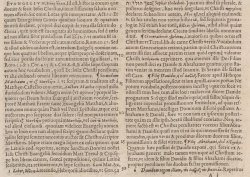

![Erasmus’ Annotations concerning Matthew 1:1 in the 1519 Greek / Latin New Testament of Erasmus.[]](/w/images/thumb/a/a3/Matthew_1_1_Erasmus_Annotations_1519.jpg/250px-Matthew_1_1_Erasmus_Annotations_1519.jpg)
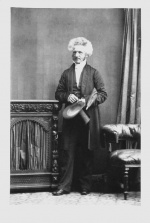

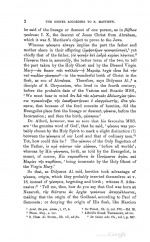
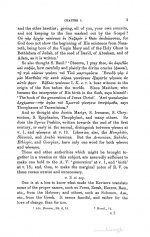
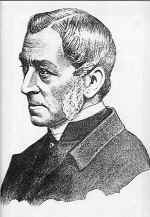
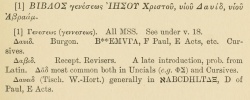

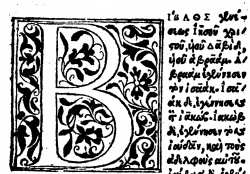

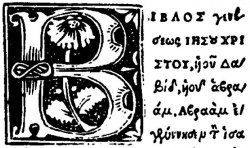
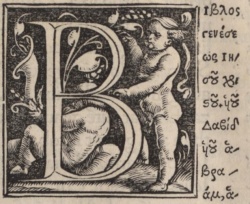
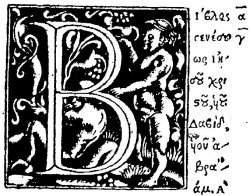
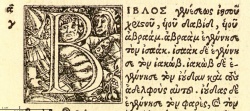
![Matthew 1:1 in Greek in the 1538 New Testament of Melchior Sessa. [3]](/w/images/thumb/8/89/Matthew_1.1_Sessa_New_Testament.JPG/250px-Matthew_1.1_Sessa_New_Testament.JPG)
![Matthew 1:1 in the 1550 Greek New Testament of Stephanus [4]](/w/images/thumb/4/49/Matthew_1_1_Stephanus_1550.jpg/250px-Matthew_1_1_Stephanus_1550.jpg)
![Matthew 1:1 in Elzevir's 1624 Greek New Testament [5]](/w/images/thumb/f/f8/Matthew_1.1_Elzevir_1624.JPG/250px-Matthew_1.1_Elzevir_1624.JPG)


